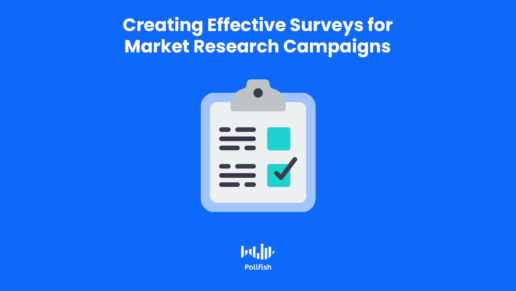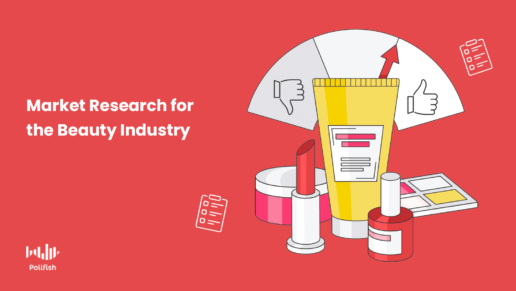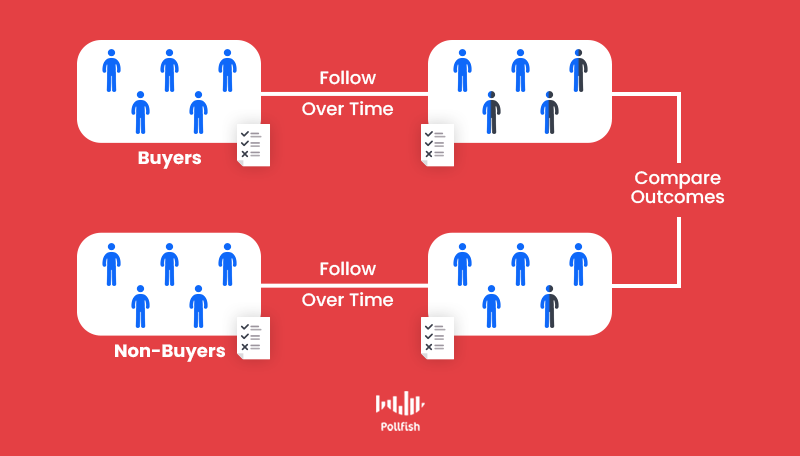How to Create Effective Surveys for Market Research Campaigns
How to Create Effective Surveys for Market Research Campaigns

Effective surveys rely on several factors in order to be vessels of value. Survey research has the potential to help businesses on so many fronts — from marketing to branding to market segmentation and more — so they must be carried out wisely.
Forging effective surveys requires these tools to garner critical customer data — the kind that has minimal biases and reaps maximum data as it relates to your campaign. In the ever-growing digital space, it is key to build surveys to study your customers and earn their loyalty.
With the rise of the e-commerce and the growing preference to shop online, competition has become increasingly stiff. As such, customer loyalty is a must, as not only is it less expensive to retain existing customers than it is to acquire new ones, but 65% of a company’s business comes from existing costumers. In addition, increasing customer retention by 5% raises profits by 25% to 95%.
Thus, brands large and small need to consistently deliver satisfying products, services and experiences to customers and it all begins by studying them. This article explains the makeup of effective surveys and how to create them so that you can maintain loyal customers and grow your business.
What Constitutes Effective Surveys
So, what exactly constitutes an effective survey? First off, you should never classify a survey campaign as effective because it resulted in the responses you hoped for. While this is certainly a positive trait and can perhaps point to happy customers, it does not signify obtaining all of your needed data.
This is because surveys are meant to collect customer dislikes, aversions, grievances and what they believe your company is lacking, as surveys are a chief Voice of the Customer (VoC) program. Further, in order to provide exceptional services, the kind that foster customer loyalty, you need to understand the shortcomings of your business.
As such, you need to provide surveys with questions that dig deep into your customers’ minds and aren’t designed to reap only positive responses. If you do so, your survey is on the right track to building effective campaigns.
The Factors of an Effective Survey
But there’s more.
Here are several other key factors that make up an effective survey. These include some of the things you should avoid in your surveys.
- Keeps survey bias to a minimum.
- Involves studying the margin of error and keeping it to a minimum.
- Maintains a stable response rate.
- Receives all the intended amount of responses.
- Only allows the targeted samples (respondents) to take part.
- This can rely on demographics and psychographics.
- Includes a survey structure and questions that motivate respondents to answer truthfully.
- Establishes results that either bear statistical significance in quantitative surveys or descriptive and psychological insights for qualitative surveys.
- Allows researchers to make informed and confident decisions on how to move forward in any particular campaign.
- Stirs actions with proven positive results (whether it’s a minor product change or an addition to an advertising campaign).
- Finds either conclusive results or the kind that make clear what kind of follow-up survey is required.
- Keeps respondents engaged.
- Avoids survey attrition.
Tips on how to Create Effective Surveys
Now that you know some of the prominent features of an effective survey, it’s time to put your survey ideas into practice, especially if you have established key components of your survey campaign. But before you begin crafting your surveys, you ought to set them up for success.
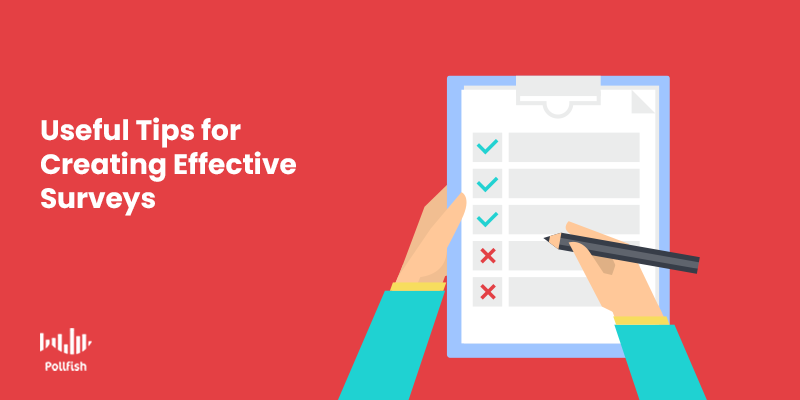
The following is a compilation of best practices for building effective surveys.
Find an overall campaign and the correct survey methods
Before you begin working on any aspect of the survey itself, you should start on a high, macro-level focused on developing effective survey studies. To reap the most out of your surveys, they should not be standalone tools; instead, they must be to a larger research effort or campaign.
Perhaps you have a survey method in mind, such as conducting a retrospective study. Next, you must find the macro-application of this survey. What is the motivation behind this survey? Is it to understand customer satisfaction or lack thereof? Is it for general marketing purposes?
Use the theme of the survey you had in mind to connect it to a specific research method, such as exploratory, descriptive or causal research. This will allow you to take timeframes, sample sizes and other considerations.
Then, find the specific survey type you’ll need to execute on your research. Let’s say, you need to measure customer satisfaction, you may want to consider specific survey types for this topic, like the Customer Satisfaction Score (CSAT) survey or the Net Promoter Score (NPS) survey.
In reference to the retrospective study example, you would need to create these surveys based on past events, to see how they affect the present state of customer satisfaction.
Choose a Frequency and Survey Deployment Method
Once you’ve found the broader survey campaign, survey techniques and survey type itself, consider how you’re going to deploy them, along with how many times.
This requires having your survey methods, survey study type and survey type itself already preplanned. This also involves having established key questions as they can help you determine how many surveys around your topic you’ll need to create and distribute.
With this in mind, consider creating at least one follow-up survey to your initial survey. You should also create follow-up questions to certain answers and route respondents to these follow-up questions — but only if they’ve responded in a way that requires the follow-up questions. This can be achieved by adding advanced skip logic into your questionnaire.
Plan Your Questions Accordingly
When you’ve decided on how you’re going to distribute your surveys, (whether it’s via email, an online survey tool or a survey panel) and have planned their frequency, it’s time to get to the heart of the survey: the survey questions, aka, the market research questions.
Consider the survey type you chose in relation to your questions. WiIl you need to ask Matrix questions, or questions on a scale? In the example of the customer satisfaction survey, you’ll most likely require using a scale or a number-based question, as those surveys deal with scores, such as the Customer Effort Score (CES).
Or, if your study is more qualitative in nature, you should ask more open-ended questions, but remember to ease your respondents into your survey; don’t ask personal or sensitive-topic questions early on.
Organize High-Level Questions Before Moving Into Subtopics
You’ll need to establish questions that deal with broader issues before you dig into specifics. However, when you’ve put together all, or most of your critical questions, you may need to cut back on some of the more general questions.
If you feel that you need to include all of your questions for your study, consider breaking your surveys up into subtopics. Remember to use skip logic in your surveys, so that respondents are only routed to relevant questions based on their responses.
Get a Few Team Members to Test Out Your Surveys
Nothing will put you in the shoes of your sampling pool like taking the survey yourself. Before you finalize your questionnaire, try to take the survey yourself, or get a few team members to test run it. This way, you’ll see if there are any missing multiple choice answers, any skip logic to add, or any other issues that need to be addressed.
Additionally testing out your survey will enable you to see firsthand how long it takes to complete your survey. This is useful in determining the length of your questionnaire. As such, taking your survey will show you whether you need to cut, elongate or keep your question length as it is.
You can also use this exercise to relay the survey’s length to respondents at the beginning of the survey.
Remember to keep your surveys short, as they are often seen as a chore rather than a fun way to kill time.
Offer Incentives

No one likes to do any work for free, even something as relatively quick as taking a survey. Thus, you should consider which of your surveys require incentives. Typically, longer surveys warrant incentives, as most people are time-poor (especially certain demographics like full-time workers).
If your survey is longer than 5 minutes to complete, offer some kind of incentive — it does not necessarily have to be monetary. It can be in the form of a discount, a giveaway, entry into a sweepstakes or even points in a mobile game.
This way, your respondents will feel rewarded for granting their time and efforts to your survey.
Be Careful With Your Word Choice in Questions
Productive surveys keep respondents until the end of the survey. This means that you ought to be careful with the wording of your questions, as they can easily throw respondents off, causing survey attrition in turn.
In order for respondents to complete their surveys, consider some question best practices:
- Don’t ask loaded questions, bear in mind the sensitivity of a subject. In these instances, respondents may answer incorrectly due to prestige bias.
- Don’t ask leading questions. Ex: Instead of asking “how helpful were our friendly customer service representatives?”, ask “how helpful were our customer service representatives?”
- Use a wider scale of answers. Ex: Instead of: very useful, somewhat useful and not useful, consider a longer scale of answers: very useful, useful, neither useful nor useless, useless, useless
- Avoid absolutes, as they lead to inaccurate answers. Ex: Instead of asking: “do you always go running after work?,” ask: “how often do you run after work?” Or “do you run occasionally or most of the time after work?”
- Don’t jam a single question with an opinion on more than one topic. Ex: Instead of: “how would you rate our in-store experience and products?” ask a question about one or the other.
Relying on an Effective Survey Platform
Forming an effective survey involves many factors. When you take each into consideration, you’re setting up your survey campaign for success. But you must remember, nothing is stagnant; there you may come upon more ways to create and maintain effective surveys.
You should also bear in mind that the success of a survey is largely dependent on the online survey platform you use. This is because these platforms help you set up the screener, the questions themselves and entirely automate the distribution/response collection process.
In order to achieve all of the components of an effective survey (see early section), you need a robust online survey platform to host your survey endeavors. A strong online tool will assure your survey respondents are randomized, avoiding biases in the process.
It will also avoid the need to study response rates, as it should continue iterating the surveys until the set amount of completes are reached.
Frequently asked questions
What are some important benefits of effective surveys?
Effective surveys involve a host of benefits for a market researcher including obtaining answers from your target population, keeping your survey bias to a minimum, maintaining a stable response rate, and avoiding survey attrition.
How can researchers create effective surveys?
You should start with a survey method in mind. Then, find the macro-application of the survey. Consider it’s motivation, purpose, and what it aims to understand. You can also use the survey’s theme to choose a specific research method. This allows you to take timeframes, sample sizes, etc. Next, find the applicable specific survey type. For retroactive studies, it’s best to create surveys based on past events to predict how they will affect customer satisfaction in the present.
How do you choose questions for effective surveys?
You can choose your survey questions based on your survey type. Depending on the survey type, you can include multiple choice questions with single answers or multiple choice questions with multiple selections. Open-ended questions are used to extract qualitative data while closed-ended questions like Matrix questions, scaled questions, and number-based questions are used to extract quantitative data (like the CES survey, for example).
Why should you connect effective surveys to an overall campaign, survey methods and macro-application?
Surveys can’t reach their full potential as standalone tools-- connecting them to a larger research effort by considering an overall campaign, survey methods, and macro-application ensures you’re getting the most out of your surveys.
What do Voice of the Customer (VoC) programs have to do with effective surveys?
A Voice of the Customer (VoC) program is one that gathers and interprets customer feedback. Because they gauge customer expectations, likes and dislikes, effective surveys are a chief VoC program.
How to Conduct Beauty Market Research Like a Pro
How to Conduct Beauty Market Research Like a Pro
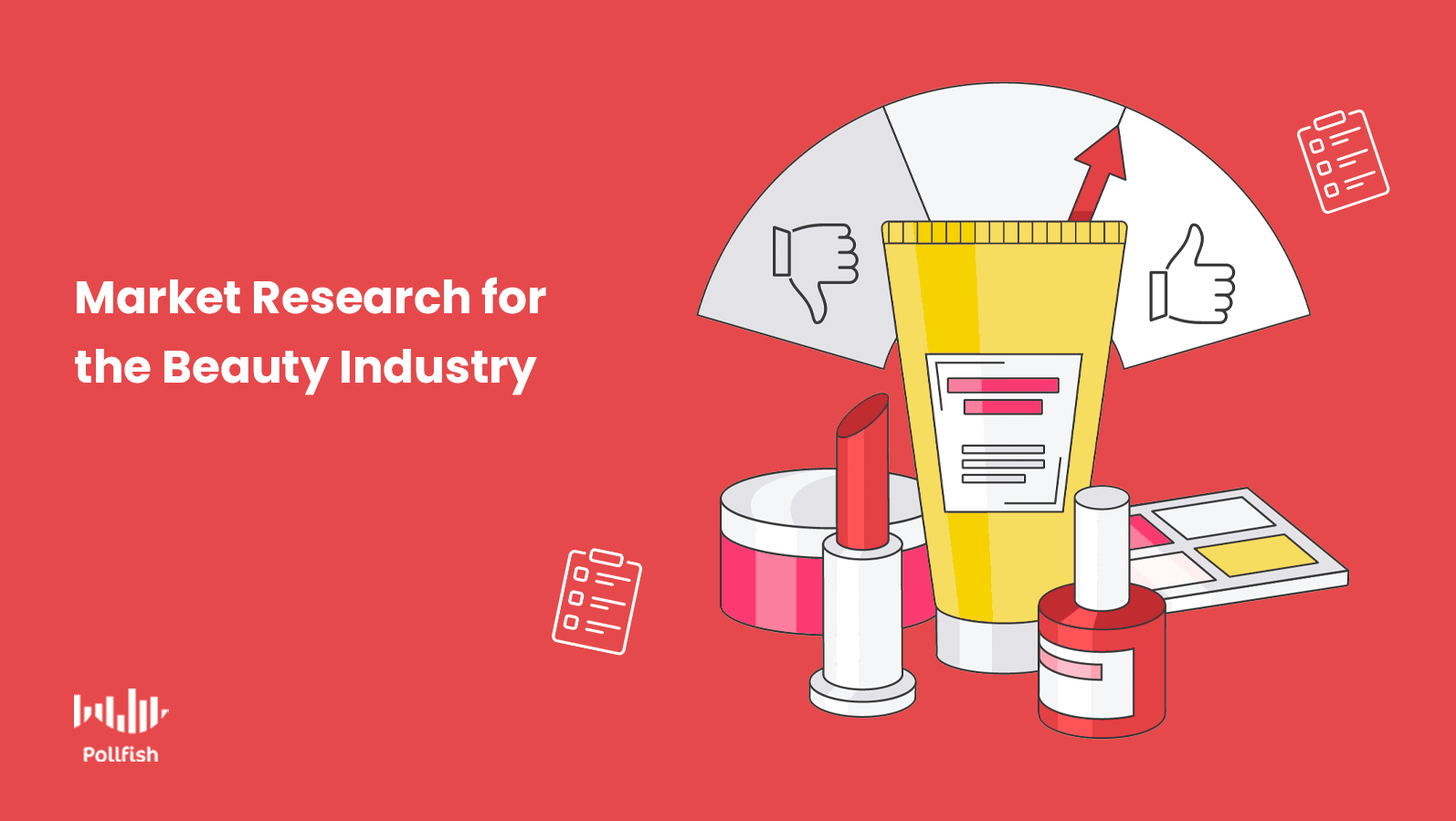
Brands that purvey beauty and cosmetics products and services must conduct beauty market research to compete with an increasing pool of businesses in this industry. By conducting beauty market research, new and established brands alike make traction.
There is no shortage of demand in the beauty industry. Currently valued at an incredible $532 billion, the global beauty industry is projected to reach $800 billion by 2025.
As such, the cosmetic industry will continue to be an attractive area for brands to grow. If you want to remain relevant or stake out a corner of the industry for your company, conduct beauty market research. It provides you with valuable data from all areas of your industry, from your specific niche, to competitors, to your market segments so that your company steers in the right direction.
This article explains how to gather your market research and give you some great sources to propel your project forward.
The Benefits of Beauty Market Research
Economists have remarked that the beauty industry is more likely to weather economic storms, as the beauty target market values quality beauty products. While they may forgo other luxuries, they continue to indulge in cosmetics for an emotional boost when times are hard.
It goes without saying that the global pandemic upended our lives and changed our daily routines. Among these changes, experts noticed the emergence of an interesting trend within the beauty industry— a pronounced move away from makeup and towards skincare.
With more time spent at home or behind face coverings, the health and beauty of skin took priority. For the first time, the “lipstick index” was overturned, with mouths behind masks, lipstick sales went into rapid decline, while mascara sales skyrocketed.
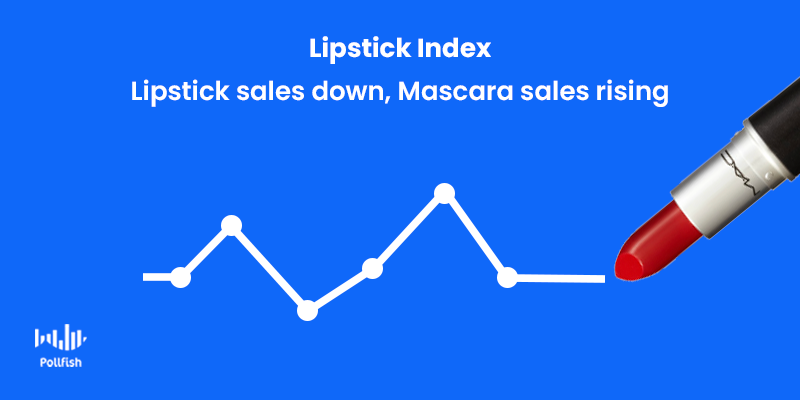
The beauty industry may be established and financially important, but it is not immune to change. Beauty market research helps businesses big and small stay abreast of these changes by providing information about:
- Skincare trends
- Consumer spending
- Emerging skincare and beauty devices
- Demographics of existing and targeted customers
- Brand perception
- Potential areas for growth in new markets
- Consumer demand for clean cosmetics
- Color palette preferences
With the shakeup that occurred in 2020, it has never been more important for beauty brands to engage in market research to ensure their product development, sales, marketing, and customer service efforts are on track.
The Makeup of Beauty Market Research
When conducting beauty market research, you will need to consult and incorporate both primary and secondary research of information into your findings, as a holistic market research campaign requires using both kinds of research. The combination of these two research sources can drive powerful insights to help shape your product or brand.
Primary Market Research
Primary market research for the beauty sector typically involves interacting directly with existing or prospective customers to gather information on your target market, along with being able to perform market segmentation to divide your overall customer base into smaller, more unique and precise market segments. Some companies choose to perform primary market research themselves, while others will outsource this to research specialists.
The most relevant sources of primary information for the beauty industry include:
- Online surveys distributed to existing or targeted customers
- Interviews (face-to-face or by phone)
- Focus groups
- Field research
- User testing
- Consumer research panels
Secondary Market Research
Secondary market research refers to the process of gathering data from published sources. This process can be expedited by purchasing high-quality market research reports in which data, statistics, and results are provided in an in-depth format.
Secondary market research can power your research project and help you identify the areas that should be explored further via primary research.
Additionally, while primary market research involves understanding your target market more, secondary research allows you to gather key data and insights from all other areas concerning the beauty industry, such as the industry at large, your niche, your competitors, the community where you seek to establish a brick-and-mortar store and all else concerning the cosmetics market.
Some of the best sources of secondary information for the beauty industry are:
- Market and industry research reports
- Statistic websites
- Trade shows
- Webinars
- Beauty industry websites
- Beauty magazines
- SEO, SEM and trends sites
- Competitor websites
Sources of Secondary Research
To facilitate your beauty market research efforts, we have compiled a list of some of the most useful and relevant sources of secondary information as it pertains to the beauty industry.

- Beauty & Personal Care Report: This Consumer Market Outlook, published by Statista, provides a wealth of information about the beauty industry, including a thorough market overview, consumer trends, information about key players, market forecasts, regional market breakdowns and analysis of the impact of COVID-19.
- Impact of COVID-19 on the U.S. Cosmetics & Toiletries Market: A breakthrough report from Kline provides vital information about how COVID-19 has impacted the beauty industry.
- Skin Care Market in the U.S.: Another trusted report from Statista, this dossier provides information about the skin care market from both a global and American perspective.
- Beauty Devices: Market Brief: This report from Kline provides information about at-home skin care products, as well as information about market size and breakdown, growth, key trends, competitive analysis and outlook through 2025.
- Clean Beauty Global Market Research Report: This report provides a detailed analysis of the global clean beauty market. This an essential guide for anyone who operates in the clean beauty sector, as well as brands who want to meet the increasingly green demands of their consumers.
- NPD Blog: Global consultancy NPD provides a vast amount of free information about the beauty industry on their blog.
- Voice of the Industry: Beauty and Personal Care: This report contains insights gathered by surveying over 1,500 beauty and personal care professionals around the world and provides a unique perspective on the impact of COVID-19 on the sector.
Gain a Unique Perspective on the Beauty Industry
Competition among beauty brands is fierce and consumer expectations are higher than ever, but beauty market research can make the difference between thriving and surviving.
As you compile your beauty market research, you may identify areas for further exploration. One of the ways to dive deeper into the needs and desires of your target audience is through online surveys.
Online survey platforms provide the software required to brainstorm, create, customize, deploy and reach your target market. In turn, you can create surveys to provide highly specific information about your target market’s needs, beauty inspirations, dislikes, shopping behaviors and much more. This will arm your brand with the competitive edge your business needs to remain profitable in the beauty industry. With this form of beauty market research in hand, you’ll be prepared for whatever lies ahead.
Frequently asked questions
What is the purpose of beauty market research?
Beauty market research is performed in order to understand the viability of a new beauty product, service, or brand, as well as allowing a company to learn more about its target market and gauge the level of interest in the product or service amongst consumers.
What insights can be gained via beauty market research?
By conducting beauty market research, a company can gain information about skincare trends, consumer budgets, demographics of target markets, new areas for growth, and perceptions of existing products or brands.
What types of research should be included in beauty market research?
Beauty market research should include both primary information (e.g. surveys or interviews about beauty products) and secondary research sources (e.g. beauty industry research reports), which are relevant to the beauty industry.
What are the most relevant types of primary information for beauty market research?
The most relevant sources of primary research for the beauty industry include surveys, interviews, focus groups, field research, user testing, and consumer research panels.
How is secondary research performed for a beauty market research project?
Secondary research involves gathering and reviewing data from existing, published sources. To gain valuable insights, it is important to identify sources of secondary information that are highly relevant to the beauty industry.
How to Increase Survey Response Rates
How to Increase Survey Response Rates

Marketers and market researchers ought to keep a watchful eye on their survey response rates. These indicate the percentage of online users who have seen and completed a survey.
If you’ve launched a survey and nobody responded to it, then have you launched one at all? Or, perhaps you’ve set one in motion, but unfortunately, it received low response rates. These are the realities market researchers face when running surveys in the wild jungle known as the Internet.
As crucial as it is to form a thorough and well-rounded survey, it is equally important that it receives the intended amount of responses. Moreover, it is crucial that these responses come from your target market and all those you target in your market research campaign.
This article covers survey response rates so that your research receives the proper amount, allowing you to draw statistical and qualitative conclusions key to help your business scale.
Defining Survey Response Rates
Survey response rates identify how many of your respondents completed their surveys. These can change from campaign to campaign and from one survey launch to the next. In any case, they all point to a specific metric that illustrates the success of your survey participation.
There are two types of survey response rates. Both use the same formula but with slightly different variables. They include the following:
The first method involves measuring the percentage of respondents who completed their survey in comparison to the number of those who viewed or started the survey. These survey response rates calculate how successful your surveys were in engaging their target audience. This method is apt for market researchers who distribute their surveys to a preset sampling pool size (usually online).
Survey response rates can also be generated by comparing survey completes to the total sampling group. This approach is used when market researchers invite specific people (as opposed to all who fit their target survey audience) to take a survey. For example, some researchers may personally reach out to their sampling pool via email, text message, social media or even a phone call to request their survey participation.
How to Calculate Survey Response Rates
As aforementioned, both approaches to discovering survey response rates use the same formula, with only mildly differing variables. The formula provides a quick and practical way to calculate survey response rates.
Use the following formulas for the two approaches:
- For the First Approach:
- Divide the number of completed responses by the number of people who either viewed or started the survey. Then multiply the quotient (the result of the division by 100).
- For example: if 300 people viewed your survey, while 170 people completed it, the calculation would be derived as follows: 170/300 = 0.566 0.566 x 100 = 56.6%
- 56.6% = the response rate
- For the Second Approach:
- Divide the number of respondents who completed the survey by those who have been invited to take part in the survey. Multiple the quotient by 100 to get the percentage.
- For example: If 400 people were invited to take the survey and 190 of them completed it, the calculation for the rate would be: 190/400 = 0.475 0.475 x 100 = 47.5%
- 47.5% = the response rate
Standard Survey Response Rates & Which to Aim For
When you endeavor to find your survey response rates, it is key to have a reference point of comparison. This way, you’ll understand how your rates measure up with standard industry rates. Additionally, comparing your response rates with benchmark rates will help you determine if they can be categorized as good or bad.
Most online survey platforms report average survey responses well below 50%. For example, PeoplePulse found that the median survey response rate of online surveys is 26.45%, while the average rate for surveys with under 1,000 participants is 41.21%. Genroe reported that a good rate is any above 25%.
This makes sense, given that most organizations report external surveys hovering around the 20% mark. Internal surveys, such as an employee satisfaction survey, generate higher survey response rates, typically between 30-40%. This is unsurprising, given that employers urge their workers to complete these surveys — and workers take heed.
Businesses and research organizations should aim for response rates that surpass 25%. Since large invitation lists are associated with lower survey response rates, it is key to keep these lists on the shorter end of the scale, with the possibility of iterating the surveys in one campaign.
The Consequences of Low Survey Response Rates
Low survey response rates have a number of consequences that businesses and research organizations ought to steer clear of. Here are a few of the negative results these rates can incur:
- Inconclusive results: When too few people take part in a survey, the results do not bear statistical relevance. This means you cannot use them for quantitative studies, which make up a large bulk of survey research. Low response rates may reap critical qualitative studies, but, when the rates are too low, the research cannot be considered conclusive.
- Uninterested survey pool: Low rates point to an uninterested group of survey respondents. This is worrisome as it requires changing minds so that would-be respondents do an about-face and complete the survey. Additionally, it is troubling as this group can be all the contacts businesses possess in an email list.

- High error levels: Surveys with low response rates fall victim to a higher margin of error. This critically undermines the accuracy of the surveys’ findings. An unfathomably high rate of 100% bears the industry brunt of a 5% margin of error. As such, this error is far higher among lower response rates, especially those that barely hit the one-third mark.
- Nonresponse bias: Low response rates often signify nonresponse bias, which takes precedence when one or more demographics in your study don’t complete a survey. This bias creeps up in a number of settings: it can be due to a lack of interest in the survey topic, your email being labeled a scam, or if you send the survey at an inappropriate time (think religious holidays)
- Repackaging of surveys: Oftentimes, to remedy low response rates, researchers have to return to already launched surveys and reiterate the survey campaign. While this can generate more results, including surveys with higher response rates, it takes more time and effort, which instead could have been spent on other survey campaigns or on the analysis portion of a survey study.
How to Increase Survey Response Rates
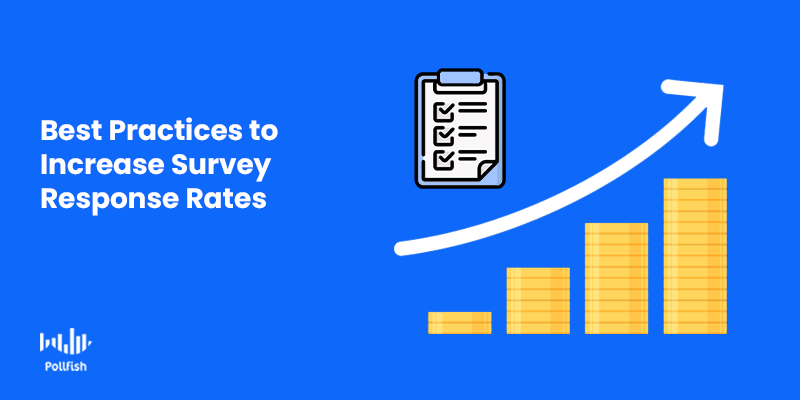
Now that we’ve covered the various crucial aspects of survey response rates, it is time to adopt certain best practices to preempt low survey response rates or increase low rates if you already have them. Here are a few methods to increase response rates so that you collect as much data as necessary.
- Shorten your surveys: No one wants to spend a significant portion of their precious time filling out surveys. As such, keep surveys, short, sweet and to the point. As such, create surveys that take no longer than 5 minutes to complete. A good rule of thumb is to keep questions at 12 and under. If, however, your survey research requires more questions, consider breaking up one survey into several.
- Add incentives: Survey incentives motivate people to take surveys, as they’ll be rewarded for their time. No one likes to do anything for free, especially the demographics that are known for being time-poor (parents, workers of more than 1 job, etc.). Researchers can get creative with their incentive offerings, as these do not necessarily have to be cash.
- Implement engaging elements: A plain survey design with text only won’t trigger anyone to take your survey. Instead, consider creating a more lively survey with less text and more visual elements such as images, short videos and GIFs. You should also expand on the types of questions you ask. For example, avoid consecutive matrix-scale or Likert-scale questions.
- Create an enticing call to action: Also known as call-outs in the context of surveys, these elements are what triggers people to take a survey (if you’re sending them via an online survey tool). These are often short and are located on a button or element which opens up or transports users to your survey. If you offer an incentive, it’s key to mention it upfront, aka, in the call-out.
- Offer the surveys across channels: Don’t settle for one website, no matter how popular it is, to dispense your survey. Instead, distribute your survey across various websites and on mobile apps, as we are living in a mobile-first world, after all. It is unlikely that your target market frequents just one digital property.
Avoiding Survey Response Rates Altogether
Your survey response rates shed light on your surveys’ performance. As such, it is crucial to maintain healthy rates — otherwise, you’re unintentionally miring your own survey data. This data is already subject to a margin of error, even with high response rates.
Since surveys are the most potent forms of primary research, it is best to avoid faulty surveys. There is one surefire way to avoid faulty surveys: by avoiding survey response rates altogether.
Does this sound impossible? It isn’t with the correct online survey tool in place. Survey software, as alluded to in the first approach, allows you to preset the exact amount of responses your survey requires, including quotas for particular respondents. These settings ensure that you only gather the responses from participants you target. It also means that the survey tool does all the heavy lifting — meaning that you don’t need to check your survey response rates, as the tool is going to run surveys until the set amount of survey completes is reached. Thereby, you avoid the need to check and stress over your survey response rates.
Frequently asked questions
What are survey response rates?
Survey response rates — not to be confused with the survey completion rate — refer to two methods that calculate the percentage of people who completed a given survey.
How are survey response rates calculated?
There are two types of survey response rates. In the first type, the percentage is calculated by comparing the total number of people who completed the survey with the total number who viewed or started the survey. In the second type, the percentage is calculated by comparing the total number of completed surveys with the total number of individuals who were invited to take the survey.
What is the average response rate for online surveys?
For most online surveys, the response rate is typically below 50%.
What is considered a good response rate for online surveys?
A good rate for external surveys is anything above 25%. For internal surveys, such as employee satisfaction surveys, a good rate is anything about 30%.
What are some of the consequences of low survey response rates?
If a survey has a low response rate, the survey is more likely to yield inconclusive results, have higher error levels, and suffer from nonresponse bias.
What are some tactics to improve survey response rates?
Some of the ways to improve survey response rates include: shorten the length of the survey, add an incentive for completing the survey, improve the format of the survey so it is more engaging, and ensure the survey is distributed across a variety of channels.
How to Conduct Luxury Market Research Like a Pro
How to Conduct Luxury Market Research Like a Pro

While luxury market research has always been important in the ultra-competitive luxury goods market, it has never been as critical as it is now. A decade of steady growth in the luxury goods market came to a crashing halt in March 2020 with the emergence of COVID-19 and subsequent global shutdown.
With airplanes grounded and shop doors closed, luxury brands have struggled to reach their customers through traditional means. While the first months of the crisis were focused on the well-being and safety of employees and customers, luxury brands are now trying to rebuild their dynasties.
Luxury market research is a practice that companies can engage in to make sense of our new reality and explore alternative sales and marketing channels. This article explores how to conduct luxury market research to remain profitable in the evolving and competitive luxury sector.
The Benefits of Conducting Luxury Goods Market Research
Since luxury items are desirable rather than essential, understanding your target market is vital to the success of a luxury product. Individuals who are able to purchase luxury goods have a unique mindset. They are set apart from the masses by their financial position and their ability to indulge in upmarket goods that are not essential to survival.
As such, marketing techniques that apply to other goods or services may not hold true in the luxury market. Luxury market research can provide invaluable insight into your target market and their motivations for buying. Some of the key reasons to conduct luxury market research include:
- Gaining awareness of your various market segments via market segmentation
- Identifying areas for growth in new markets
- Gaining insight into consumer spending on luxury products
- Learning consumer behavior on luxury websites
- Understanding how your target market defines or measures the quality
- Determining an appropriate price point for your product or service
- Learning what marketing and advertising campaigns will convince your audience to buy
- Measuring brand awareness and outline strategies for growth
- Improving communication and messaging with existing customers
- Understanding how your product compares to others in your niche
The Makeup of Luxury Market Research
In order to gain valuable insights, your luxury market research project should include research from two sources - primary and secondary information. The primary and secondary sources that you chose to utilize will depend upon the goals of your market research project.
Primary Research
Primary research is performed by gathering and analyzing information from first-hand sources. While it can be challenging to gather primary information - especially within the luxury goods sector - the payoff is high because it provides you with insights that are unique to your particular company, brand, or product.
The most useful types of primary research for luxury market research include:
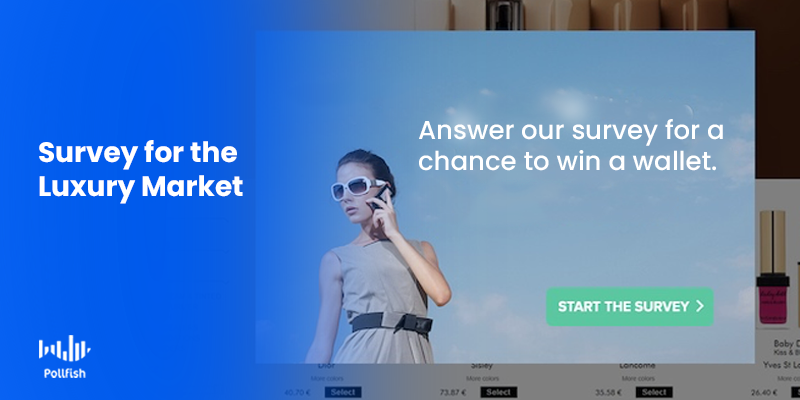
- Online surveys of existing or targeted customers
- In-person or phone interviews
- Focus groups
- Field research
Secondary Research
Secondary research involves gathering and analyzing data from existing, published sources. Secondary research requires combing through large amounts of information to identify the sources that are most relevant to your business. Examples of secondary information are:
- Luxury market research papers
- Industry reports
- Research agencies
- Case studies
- White papers
- Statistic sites
- SEO and keyword research
Secondary Research Sources
At the outset of your luxury market research, you should focus on gathering information from existing sources. This can provide you with a strong understanding and help you identify the focus of your primary research endeavors.
Here are some excellent sources of secondary information that are relevant to the luxury goods sector.
- Statista’s In-Depth Luxury Goods 2020: This focuses on the current state of the luxury market and includes information on market share, trends, segment analysis, the impact of technology, analyses by country, and overview of the competitive landscape, which covers some of the biggest players in the industry. Published in August 2020, the report pays special attention to how the economic fallout of COVID-19 will shape and redefine the industry.
- Luxury market industry reports from MarketResearch.com: Trusted source for market research reports, this source spans a wide variety of topics. In the luxury market category, there are numerous reports covering luxury apparel, shoes, watches, fine wines, cosmetic products, and more.
- World Market for Luxury Goods report: This comprehensive report on the luxury goods industry provides a broad overview of the market and outlook for the luxury goods market. Due in early 2021, the next annual report will contain information on how COVID-19 has changed the market.
- The Age of Digital Darwinism: This is a free report published by McKinsey that provides insight into how luxury brands can compete in an increasingly competitive digital arena.
- Luxury Personal Goods Industry Worldwide: Another valuable report published by Statista, this dossier provides a number of facts and statistics about the worldwide luxury goods industry.
Navigating the Luxury Market Post-COVID

When factories were shuttered across Italy, one of the leading producers of luxury goods, the production of luxury goods suffered a major setback. Stores across the world were closed just as spring and summer collections should have been released. Without the in-store experience, luxury brands suffered financially; sales were an estimated 70% lower than they were in 2019.
As luxury brands look for a way to rise from the ashes and reach consumers in new ways, luxury market research has never been more important. Brands will need to make adjustments in how they market and distribute their products. Before making a massive investment, they must do their best to ensure the new strategies are sound.
Luxury brands will need to consider how to create products to meet evolving needs, envision new shopping experiences, and design marketing campaigns that address this new reality.
Market research is a surefire way to gather critical insights on your target market, competitors and industry at large. In turn, this will pave the way for success The use of online surveys, virtual focus groups and interviews can help luxury brands make smart decisions about how to connect with their clientele and ensure their future prosperity.
Frequently asked questions
What is luxury market research?
Luxury market research is the process of gathering and analyzing information in order to gain a clear understanding of how a luxury goods business fits into the competitive landscape.
What are the benefits of luxury market research?
Luxury market research can help luxury brands gain a better understanding of their target market, identify new areas for growth, learn the ideal price of items, improve communication between the brand and existing customers, and understand how the company compares to the competition.
What types of primary research are helpful for luxury market research?
The most useful types of primary research for the luxury goods market are surveys, interviews, focus groups, and field research.
What is luxury market secondary research?
Secondary research for the luxury market is the process of gathering and analyzing existing publications and data from sources that are relevant to the luxury goods market.
How is luxury market research performed?
First, the goals of the luxury market research project are established. Then, the research team will conduct primary and secondary research to gather large amounts of information. After performing analysis, the information is organized into a luxury market research report.
How to Avoid Survey Bias in Your Market Research
How to Avoid Survey Bias in Your Market Research
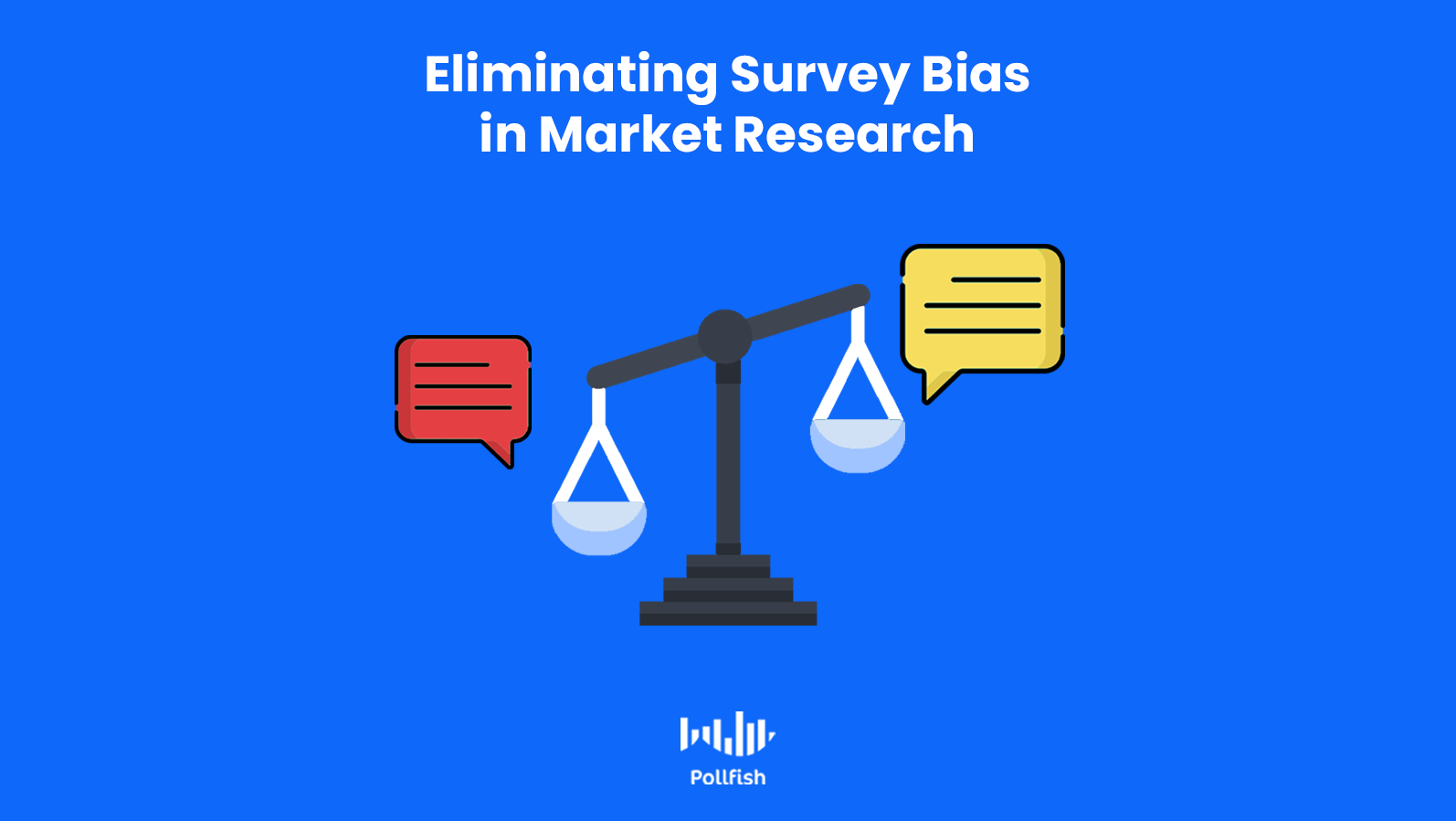
Survey bias is one of the biggest roadblocks in market research. Although online surveys are powerful agents in gathering primary research, they are susceptible to unreliable and sometimes inaccurate results. This is due to survey bias.
Unfortunately, survey bias is inevitable, as several aspects can contribute to inaccurate results, many of which are out of the researchers’ control. However, understanding the main types of biases that can arise is critical for avoiding them.
While no one can fully weed out bias from surveys, there are certain measures researchers can put into practice to fend them off. This article illustrates the makeup of survey biases and how to avoid them.
For more information on survey bias, read the Pollfish Ultimate Guide to Remove Sampling Bias and More. This article will cover certain biases not mentioned in the guide.
Defining Survey Bias
Survey bias is an encompassing term that does not simply refer to results that are unrepresentative of a studied population. Survey bias is a general term for a variety of biases that influence respondents to provide dishonest or inaccurate answers. These invalidate the findings of a survey.
There are two main types of biases that occur in survey research: survey errors and response bias.
Survey Error
This type of error is rendered when researchers use faulty means in creating a survey, i.e., its screeners, quotas, questions, etc. Referring to the survey-production process, this type of error can also occur in administering a survey and even in post-survey analysis.
The latter is known as researcher bias. (More on this in a few sections below).
The survey error is a type of bias that lies entirely on the researchers’ end, as they are responsible for producing the surveys and their processes. As such, it can be avoided via actions taken on the part of the in-house or external research side of the survey campaign.
Response Bias
Unlike the survey error, which comes from the researcher side, response bias occurs from the survey participants, i.e., the respondents. Response bias occurs when respondents are influenced into providing answers on a survey. A general term, this type of bias can result in a variety of inaccurate responses. This bias can appear either deliberately or subconsciously from the respondent.
Respondents can be influenced to answer questions in a particular way or they may exhibit reluctance to provide accurate answers themselves. In this regard, there are many types of survey respondents to look out for.
As a market researcher or survey maker, you ought to ensure you’re implementing efforts to reduce the many varieties of these two main survey biases.
Survey Errors
Construed from the research end of the survey research process, survey errors can occur in the questionnaire, the screener, the distribution/collection stage, or from the interpretation of the researchers themselves. Here are the key survey errors prone to occur on the research side and how to avoid them:
1. Sampling Bias:
This relates to a bias that occurs in the respondent selection process, specifically when a survey sample (group of respondents) is not chosen at random, or not completely at random. This leads to under or overrepresentation of a certain segment of your targeted population, as only certain types of respondents are taking part.
How to reduce sampling bias: Researchers need to employ several methods of distributing their surveys, so that respondents are as randomized as possible. This includes making mention of it on emails, websites, social media and even physical locations. Alternatively, researchers can use an online survey platform, one which features a large network of publishers. This will ensure that the survey is exposed to thousands, if not millions of people online.
2. Survey Scope Error:
This error occurs when researchers leave out critical questions needed to fully complete the research around a topic. This results in incomplete findings that require follow-up surveying, which is only possible if researchers use a survey panel. Otherwise, despite deploying surveys to the same market segment, you won’t receive answers from the same respondents due to the nature of random device sampling found in many online surveys. Survey error renders survey research to lack critical aspects of a topic or inquiry.
How to reduce the survey scope error: Create a list of questions and answers before setting up your survey. Consider the answer options you give, will any of them require further probing? If so, create question paths to send respondents to the appropriate question based on their previous answer. This allows you to probe deeper into a topic or subtopic. Follow-up questions can be open-ended. If you require too many questions, making for a long survey, consider breaking up the survey based on subtopics as online users are unwilling to answer lengthy surveys, no matter how well-built the survey platform you use.
3. Order Bias:
This refers to the bias that arises due to an ill-conceived order of questions and answer choices. This is to say that this bias occurs when questions asked early in the survey affect how respondents answer questions later on in the survey. Order bias can exist in two varieties. One is the assimilation effect, where the response to a concluding question is based on the former questions asked.
Ex: When conducting a customer satisfaction survey, researchers ask several questions on the CX of a brand, with the final question on the overall experience. The questions leading up to the final question all deal with similar aspects of the experience, therefore influencing the response to the final question. In this case, the response to the final question would be similar to the former questions. Asked on its own, however, it would likely receive a different response.
The second type of order bias is the contrast effect, wherein the response to a concluding question is not similar to prior questions, but more severe in comparison to them than it would be if it was asked earlier on or by itself.
Order bias can also occur due to the types of answers the researcher provides in multiple-choice questions, as respondents prefer to answer with the first few responses.
How to reduce order bias: Randomize question and answer options. It also is key to reduce the number of scale questions per survey. When too many such question types are used, you are bound to create the assimilation or contrast effect. Ask questions that better engage respondents; include multiple and single-selection answer questions, questions with visual elements and open-ended questions.
4. Purpose Creep Error:
This refers to the error that emerges when researchers include unnecessary items in a survey, typically for the sake of obtaining an exhaustive data collection. This action is called a purpose creep. Essentially, this kind of action creates superfluous data, the kind researchers won’t need to use when analyzing or presenting their findings.
Furthermore, in an attempt to avoid discarding data, researchers may study unneeded aspects of the survey, such as demographics that aren’t needed or tidbits about the target market that are not entirely relevant to examine. Asking unnecessary questions can also negatively affect the respondents’ experience, leading them to answer untruthfully or leave surveys incomplete.
How to reduce the purpose creep error: Consider the key demographics, screening questions and topics you need to base your survey on. When you prepare questions, look them over before launching the survey to see if there is anything redundant. While some aspects may seem interesting, they may not be entirely pertinent to the survey and overall study.
Survey Biases
Survey biases occur within the respondents themselves, commonly when they are influenced to answer or behave in a particular way. It can also exist from within, meaning that the respondents are inclined to misunderstand questions or easily get bored. Here are the key survey biases common on the respondents’ side of survey research and how to avoid them:
1. Acquiescence Bias:
Also called agreement bias, this bias occurs when respondents gravitate towards positive or agreeable answers. In this bias, respondents will exhibit the propensity of frequently choosing answers with positive associations. They do this as these answers feel like the correct choices. This kind of bias is more prevalent in Asian cultures, as a study found.
This bias also rears its ugly head when respondents feel tired and thus answer questions without applying any thought to them.
How to reduce the purpose creep error: Create questions with answers that don’t allow respondents to make positive or negative associations. As such, researchers should avoid using questions that ask if the respondent agrees with an idea. For example, instead of asking:
Do you agree with the following statement? "I found the new feature easy to use."
- Agree
- Disagree
Ask,
What do you think about the new features in terms of ease of use?
- I think the feature is easy to use.
- I think the feature has to be studied.
2. Prestige bias:
Prestige bias is tied to respondents’ social desirability, as it deals with responses made specifically to be seen positively. This can manifest in instances where respondents are asked about their income or their associations with notable actions. In these cases, respondents exaggerate to make their circumstances appear more socially desirable. Many times, this bias occurs indeliberately, as respondents may recall memories in a way that’s more favorable to them as a subconscious way to protect their reputation.
How to reduce prestige bias: Screen your survey participants for their knowledge of certain things relating to the study. Also, be sure to preset the audience with demographics that fit a certain level of education. Ask questions in a way that avoids cheating positive or negative associations. Also, it will help to add a disclaimer at the beginning of your survey, that claims it is a judgment-free study and solicits respondents to answer honestly.
3. Demand Characteristic bias:
This bias develops when a demand characteristic is present. This phenomenon denotes cues in the survey that unintentionally influence how responders answer questions. A demand characteristic can take place if the researcher gives away the purpose of the survey or study. As such, the main purpose of a survey should not be overt in the setup of a survey. When a respondent knows the purpose of a study, they may purposely provide answers to influence the study, especially if this will benefit them. Ex: if a survey is conducted to determine a municipal law, the respondent may provide answers that would make the outcome of the survey favorable to them.
How to reduce demand characteristic bias: Researchers should keep the main purpose of a survey private. As such, they can forgo a welcome page that respondents would otherwise see before taking the questionnaire or answering the screening questions. The wording of the questions should not make the purpose of the study too obvious; therefore, researchers can use analogies and keep certain topics vague.
4. Random Response bias:
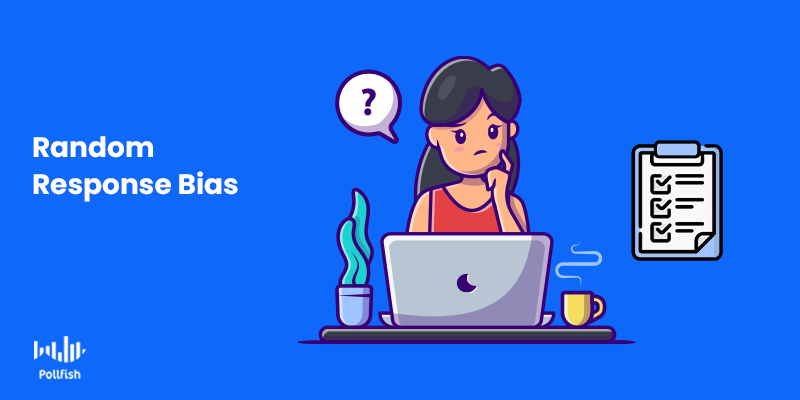
This bias comes into being when a respondent does not know how to answer a question, but does so anyway, creating inaccurate results that are random at worst. In this scenario, respondents guess an answer rather than providing authentic information. This bias is also exhibited when respondents don’t read the questions, deliberately randomly answering them to quickly finish the survey. This is usually seen when there is an incentive that requires completing the survey.
How to reduce random response bias: When forming the questions, consider your target market with them. Will they understand your questions? Will they know how to respond accurately? Avoid asking questions that deal with how respondents perceive others to think or behave. To catch this bias in action, add trigger items, such as an item that is opposite to another, or reverse scoring to catch potential bias.
Staying Clear of Survey Bias with the Right Online Survey Platform
While providing a potent channel for primary research, surveys are bound to incur bias, whether it manifests in survey errors or survey bias. Often, survey errors — those which are made on the part of the researchers, generate and influence survey bias — which occurs on the part of the survey subjects, i.e., the respondents.
Therefore, researchers should always scrutinize their survey efforts, both in the screening and questionnaire portions of the survey they’re launching. An online survey platform can help minimize errors as a potent one provides randomization of respondents and many question-and-answer option setups.
While certain biases are unavoidable, researchers ought to carefully assess the online survey tool they intend to use for their survey research.
Frequently asked questions
What is response bias?
Response bias is an umbrella term for a variety of survey issues that may cause survey respondents to answer questions incorrectly or inaccurately.
What is sampling bias?
Sampling bias is an effect that occurs when data is collected from a population (i.e., the sample) in a non-random way. This results in a biased sample that does not accurately represent the larger population.
What is a survey scope error?
A survey scope error is an effect that can occur when researchers omit certain important questions that are necessary in order to fully understand a topic.
What is acquiescence bias?
Acquiescence bias, also known as agreement bias, is a common survey error that occurs when individuals have a tendency to agree rather than disagree with a question.
What is random response bias?
Random response bias describes the tendency for a survey respondent to answer a question randomly, rather than accurately. This can happen if the respondent does not understand the question, does not know how to answer the question or is in a hurry to complete the survey.
The History of Survey Platforms & Technology
The History of Survey Platforms & Technology

In the time since the first survey was conducted, surveys have evolved to become one of the most common methods of researching groups of people. Survey platforms have further revolutionized the way we collect and analyze data, making it easier for researchers to identify trends and draw conclusions more quickly and accurately.
Interestingly, the need to conduct surveys and manage the resulting data was one of the driving factors in the development of early computing technology. While survey platforms are a relatively recent concept, the development of computing technology to support survey data has been around much longer.
This article presents the history of survey platforms to show just how online survey tools have morphed into the market-research powerhouses of the digital age.
Well-Known Early Surveys
Surveys have not always been a standard component of research, in fact, they have been in use for less than 200 years. The earliest known survey was conducted in 1834, by the Statistical Society of London. It was a simple, door-to-door survey that sought to understand the occupations of people living in Manchester, England.
The American Community Survey (aka, the US Census), conducted every 10 years, is likely the most well-known American public survey. This massive undertaking seeks to obtain demographic data about every household in the United States via a survey. The manner in which it has been conducted has changed dramatically since its conception in 1790.
During the very first census, the count was performed via a physical visit to every household in the United States, but this gave way to phone, mail, and eventually online data collection.
Nielsen ratings are another example of prominent public surveys. Conducted every year since 1947, this survey collects information about how Americans of various demographics consume media. Media outlets, businesses and marketers rely upon these surveys to make decisions about how to evolve their products, choose the proper media advertising channel and run effective marketing campaigns.
You may wonder how these massive amounts of data were collected and analyzed before the existence of computers. Interestingly, it was the need to collect and organize exactly this type of data that led to the development of computing power.
The Punched Card Tabulator

The development of the punched card tabulator marked the first major breakthrough in the way we collect survey data. In the late 1800s, the United States experienced unprecedented population growth, due to the large number of immigrants migrating to the country. When it came time to conduct the 1890 census, government officials noted that it would take over 8 years to count the resulting data from the census.
An enterprising young engineer of the time, Herman Hollerith proposed a solution. He designed a system whereby a paper card with a series of punched holes would represent each individual’s census information. While the collection of this data was manual, the processing of the information could now be automated.
Thanks to Hollerith’s creation, the census count took just two years and saved the US government $5 million. Hollerith turned his machine into a business, which he named the Tabulating Machine Company.
His machine soon became commonplace in the back offices of a wide variety of industries throughout the world, including railroads, oil companies, drug manufacturers, utility companies, and large department stores.
His machine was later sold to the Computing-Tabulating-Recording company (C-T-R), which evolved into IBM in the 1920s. His design transformed data processing in nearly every industry in the world and paved the way for the development of the computing giant, IBM.
Punched Card Statistical Analysis & the Rise of IBM

The creation and subsequent development of IBM into a computing super-giant had its very roots in survey data collection.
In 1928, IBM introduced an evolution of Hollerith’s punched card tabulator and named it the “IBM Computer Card,” which was commonly referred to as the IBM card. Remarkably, this seemingly simple invention was one of IBM’s most important technological advances and was responsible for the rise of IBM as the data processing giant in the early 1900s.
Today, with the proliferation of data and computing systems, it seems hard to believe that IBM’s cards held nearly all of the world’s data for almost half a century. Not only did the cards advance data processing, but they created a steady profit stream that allowed IBM to develop into the company it is today.
The IBM card allowed customers to store a large amount of data, thanks to its 80-column format and character codes. The challenge then was to develop a system that could make sense of the huge amounts of data that were stored on these cards. The device used to process this information was known as a tabulator.
During World War II, IBM developed the earliest type of supercomputers in order to process data that was stored on these cards. While these computers looked and acted nothing like computers today, the concepts used to convert and process data stored on physical cards into a digital format set the foundation for the later development of modern computers.
Computer-Assisted Survey Information Collection (CASIC)
From the 1950s, the use of computers to assist in the collection and analysis of survey data became more frequent. The use of computers in any aspect of survey creation, distribution, or analysis, is referred to as computer-assisted survey information collection (CASIC).
CASIC made it easier and faster to compile, store, and analyze data, which increased both the popularity and reliability of surveys. Computers helped lower the cost of survey research, reduced errors during data entry, and improved data quality by eliminating interviewer bias.
Before the existence of the Internet, computers were utilized in various ways to support survey research.
Applications of the CASIC
Here are some of the many ways that computers were used to collect survey data:
- During phone or in-person interviews, the interviewer reads from a computerized questionnaire and enters the respondent’s answers.
- An individual sits at a portable computer to read and answer survey questions.
- Surveys are distributed to respondents via a floppy or optical disk, which is returned by mail.
- Touch-tone data entry (TDE) allows the respondents to answer questions by phone by pressing numeric keys.
- Respondents answer questions by phone, which are then recorded and automatically transcribed into text.
In each of these modes of collecting survey data, the information is digitized, making it easier to store, analyze, and update the data with subsequent survey iterations.
The Development of Online Survey Platforms
While surveys have been in existence for nearly 200 years, the relatively recent development of online survey platforms marked the most dramatic evolution in how surveys are conducted and analyzed. The ability to oversee the entire lifecycle of a survey from a computer represented a fundamental change in the world of market research.
Before the advent of online survey platforms, the process of creating a survey, distributing it, and then analyzing survey data was a cumbersome and time-consuming process, even with CASIC technology. With the development of online surveys, survey research has become a critical tool for a wider range of research fields, such as marketing, social studies, and official statistics.
Online survey research offers distinct advantages in comparison to pre-Internet CASIC methods. These include:
- More cost-effective
- Easier to design and develop
- Faster data collection and processing
- Option to include advanced skip logic
- Ability to provide inline support to respondents as needed
- Ability to respond to the survey on any device
Online Surveys for Businesses, Banks Government Entities & More
Today it is hard to fathom how surveys were conducted before online methods were available. It required a staggering amount of manpower and determination to collect data from populations and then make sense of that data.
Thanks to online survey platforms, surveys are widely used to collect information about any number of topics. Whether they contain one question or hundreds, surveys have become commonplace in our study of the world around us.
Surveys can be deployed in a matter of minutes, giving businesses an easy way to understand their customers in order to improve their products, services, and interactions.
Frequently asked questions
How did the punched card tabulator advance the process of survey data collection?
The punched card tabulator made it possible to automate the process of counting survey results. This greatly reduced the amount of time and manpower required to compile survey data.
Who developed the punched card tabulator?
Herman Hollerith developed the punched card tabulator, which was later sold to the Computer-Tabulating-Recording company.
What was the IBM Computer Card?
Also known as the IBM card, the IBM Computer Card was a standardized card format that was used to store data via character codes in an 80-column format.
What is Computer-Assisted Survey Information Collection (CASIC)?
Computer-Assisted Survey Information Collection (CASIC) refers to any use of computers to help in the collection and/or analysis of survey data.
What is an online survey platform?
An online survey platform is a tool that allows surveys to be created, distributed, and analyzed from a centralized, remotely-accessed, digital platform.
The Best Survey Incentives to Increase Survey Participation
The Best Survey Incentives to Increase Survey Participation
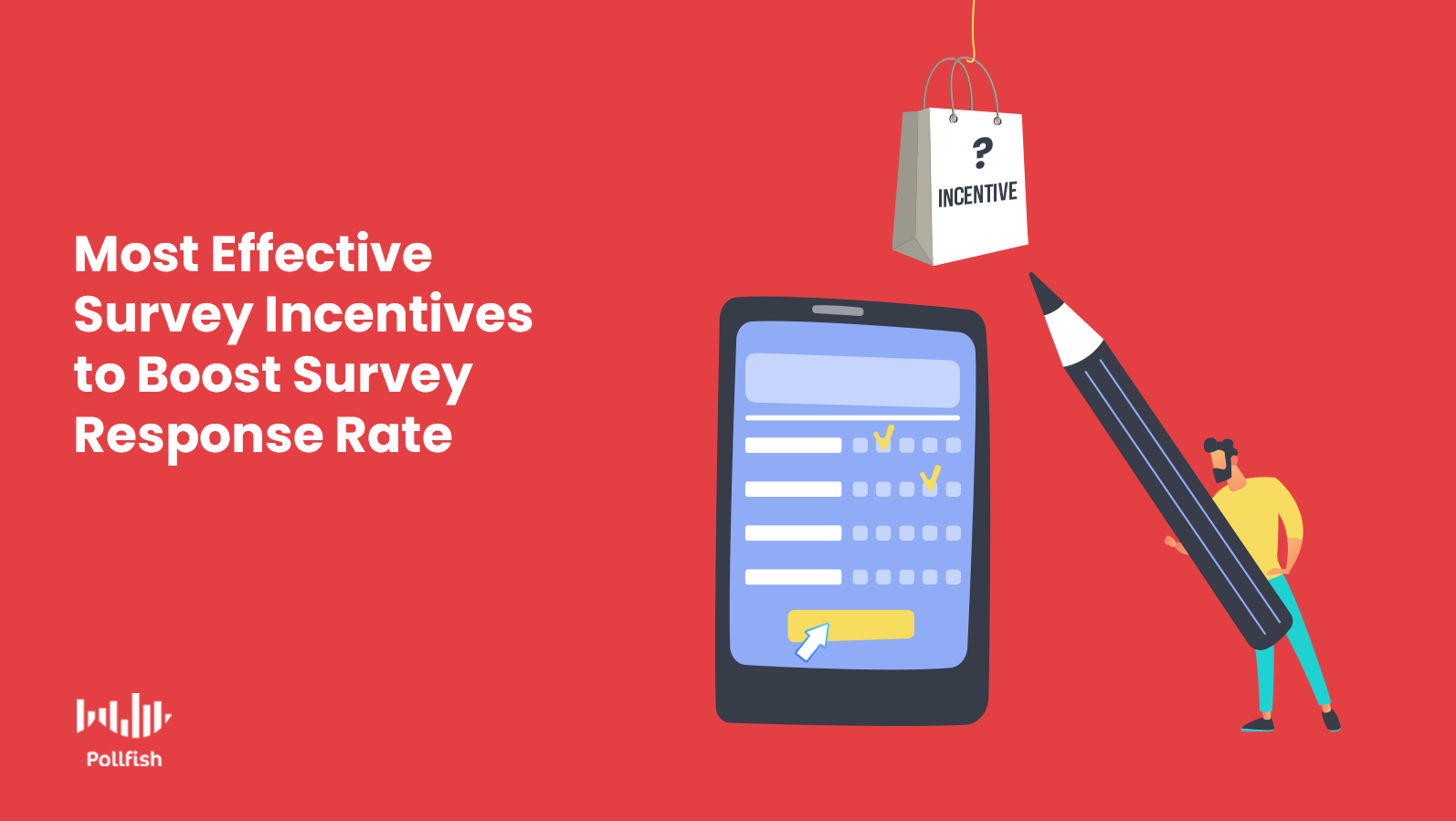
Survey incentives are invaluable to the online survey experience; market researchers and business owners benefit by implementing them into their surveys to increase participation.
This is largely because taking part in a survey, brief as it may be, is not everyone’s cup of tea. In fact, survey response rates fall on the lower end of the scale, with online survey response rates totaling to roughly 26%, aka under one third.
It should come as no surprise that many online users simply have no interest in taking a survey, as they are exposed to so many other on-site elements that draw their attention.
In this way, having a survey distributed on a popular website or app can be a drawback, as users’ attention can easily be consumed by the contents of their digital environment.
Survey incentives are proven to increase survey response rates, thereby increasing target market respondents in your survey. Additionally, by adding more appeal to a survey, online survey platforms can accumulate more completes in a quicker time
This article will cover survey incentives, why they matter and the best kinds to use to increase survey participation.
Defining Survey Incentives
As its name suggests, a survey incentive incites survey participants (or targets) to complete a survey by gifting them with some kind of stimulus.
Incentives can take various forms, which is where marketers and market researchers can let their creativity take the wheel. This is useful as brands often reveal they are behind a survey when they provide incentives (unless their incentive strategy involves partnering with the publishing websites of their surveys, in which case, the publishers are attributed with the incentive).
Regardless of who gets credit for providing the incentive, it is necessary to draw in interest and truthful responses from online visitors. It is also a valuable way to thank survey respondents, as a thank you note alone will not suffice.
Monetary Vs Non-Monetary Survey Incentives
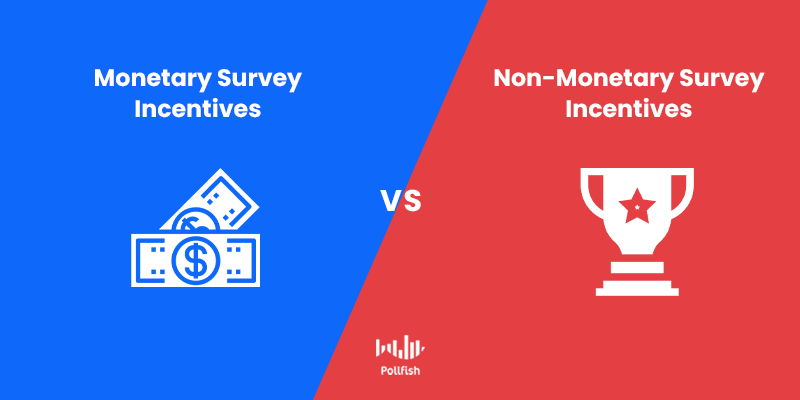 Incentivizing respondents is divided into two major forms: monetary incentives and non-monetary incentives. Both are effective drivers of survey engagement and can drive repeat participation, the latter of which is critical for longitudinal studies.
Incentivizing respondents is divided into two major forms: monetary incentives and non-monetary incentives. Both are effective drivers of survey engagement and can drive repeat participation, the latter of which is critical for longitudinal studies.
The following expounds on both chief incentives.
Monetary Survey Incentives
These are money or currency-based gifts that researchers use to reel in survey respondents. The responders receive the incentives only after completing their surveys. A potent online survey tool ought to be able to distinguish between a fully completed survey and an invalid survey.
For example, it should be able to mark gibberish answers and identify flatliners and other types of suspicious survey respondents.
Here are a few useful monetary incentives to employ, including best practices on when and how to use them.

- Cash (Via direct deposit or a digital payments system, i.e., Paypal).
- How much? It depends on the length and audience of the survey. Ex:
- A five-minute survey for students should be incentivized by approx. $1-$10.
- A 20-minute survey for clinicians, scientists and other professionals should be $30-$100.
- How much? It depends on the length and audience of the survey. Ex:
- Gift cards
- Gift cards to your own business will not solely be an incentive but will draw attention to/promote your business. It will also not cost brands any money (as the card is redeemable at their business).
- Gift cards to popular retailers within your target market. This requires running primary and secondary market research to understand and segment your target market.
- The price range should correspond with the time required for the survey. Ex: $5-$15 for a survey taking about 15 minutes.
- Coupons
- Like gift cards, coupons can be offered to your business, or a popular one among your target market (NOT your competitors’).
- Coupons should offer markdowns and discounts on popular products and services.
- The offer should hover around 25% off.
- Checks/Money Orders
- Will require collecting more personal information from respondents, such as addresses. This can serve as proof of residence in a particular demographic area if you need residents of a specific geographic location.
- Keep the price ranges congruent with the amount of time/effort of a survey.
- Ex: $5-$15 for surveys taking 10-15 minutes.
- Donations to Charity
- These are donations you send to charities or causes for the better good when respondents complete a survey.
- Brands can give respondents the option of sending the donations on their behalf, i.e., with their names as the donors.
- This involves picking a charity that relates to your niche and is recognizable by your target market.
- The price range can be concrete — $1-$20, or it can be expressed as a percentage, i.e., 10% of profits will go to a charity.
Non-Monetary Survey Incentives

These incentives coax respondents to complete surveys through non-monetary offerings. They still offer something of value to the respondent. This is a more practical use for B2B brands, as small monetary incentives often won’t be enough for, let’s say a SaaS company. This opens the door for more types of incentives.
Below are some of the kinds to employ, along with their best practices.
- Product Samples
- These allow businesses to save money and resources. Plenty of people may send requests for product samples, but are they actually considering making a purchase? This answer may vary. But when you use samples as an incentive, you are guaranteed to gain something critical in return: customer data.
- These samples should correlate with the efforts required for the survey. As such, small surveys should call for small samples (think in terms of both size and type of product).
- Trial Subscription
- Much like samples, these offer a sampling of a service. If you offer media such as online magazines, news sources, trade publications or video content, consider offering a free or freemium trial.
- The trials should run no more than 4 days to a week.
- Loyalty Programs
- Both a practical non-monetary incentive and a method for building customer loyalty, this type of program will give respondents a taste of what your top customers gain when earning loyalty points, likely stoking their interest in your business.
- Loyalty programs work by offering points, which help customers earn freebies or other perks.
- Offer 1-2 loyalty rewards at most for survey completion.
- Company Literature
- Most useful for B2B respondents, who are intent on learning about a particular discipline that your brand offers in its marketing content.
- Examples include white papers, industry and consumer reports, webinars and video content.
- This is most ideal when studying professionals or hiring survey panels.
- Partnership Benefits
- This is a mutual incentive for companies that want to partner up for collaborative survey research. (Ideal for both B2C and B2B businesses, including SaaS companies)
- How it works: Your business grants small discounts to the partnering company’s customers; the partner business follows suit for your customers.
- Partnerships and other business affiliations provide more exposure for your business.
Hybrid Incentives
When brainstorming survey incentives, you need not rely on one of the chief, aforementioned methods. This is because you can merge these approaches by offering multiple incentives. This is especially useful when dividing surveys across market segments, as certain segments may be more receptive to one form of survey incentive over the other.
Additionally, there are methods that allow you to offer either monetary or nonmonetary incentives. Here is the following list of such means:
- Sweepstakes
- Also called a raffle or a drawing, sweepstakes provide an exciting opportunity for respondents to win a prize, when chosen at random.
- The prize can be monetary or a product, service, experience, etc.
- Every respondent taking part in the survey should have an equal chance of winning.
- Giveaways
- Similar to sweepstakes, giveaways allow respondents to win something either monetary or nonmonetary via a drawing.
- However, giveaways can give all survey respondents the assurance of winning something.
- The difference lies in what respondents can receive, not if they will receive something at all, as in with sweepstakes.
- Ex: One responder may win a magazine subscription, while the other may win a coupon.
- Games
- Following suit with sweepstakes and giveaways, games allow for a more creative way to incentivize respondents.
- Businesses can enter respondents to play a game, granting them the chance to win a prize.
- Only the winners will be sent a prize. This is ideal for those seeking something more than just receiving a reward.
When to Use Survey Incentives
Market researchers and business owners can best benefit from survey incentives to motivate a targeted audience they have less data about. For example, perhaps not all of your quotas on one demographic or psychographic population are being filled. A survey incentive can buttress this obtaining this objective.
Or — perhaps your survey response rates are low. Implementing survey incentives will boost this metric. No one wants to do anything for free, regardless of its simplicity and little timing.
Then there is the case of supply. Some businesses have plenty of leftover samples from a particular campaign, whether it was sending samples to those who requested them or sending goods to other businesses as part of an ABM campaign used in marketing. Rather than discard these items or let them collect dust, you can repurpose them for survey research.
The Online Survey Tool as the Survey Incentive
A robust online survey platform is a necessity for any marketer or market researcher, even with a steady survey incentive strategy in place. This is because an effective online survey tool won’t stop iterating surveys across a wide online ecosystem of websites and apps until it receives ALL the preset number of survey completions.
However, brands would be remiss to completely disregard the survey incentive approach, even with a strong survey platform in tow. This is because offering incentives will cast your business into the minds of your target market, i.e, the most valuable customers and prospects.
The experience of gaining something (the incentive) from a brand is far more memorable than simply taking a survey that mentions a brand.
Thus, by providing customers with a survey on matters relevant to them and offering them an incentive, which can be your company’s product, you are differentiating your brand from that of your competitors.
Frequently asked questions
What is a survey incentive?
A survey incentive is anything that encourages individuals to participate in a survey. The incentive itself can come in a wide variety of forms, ranging from discount codes, monetary compensation, content, and more.
What are examples of monetary survey incentives?
Monetary survey incentives can take the form of cash or checks, gift cards, coupons, discount codes, and donations to charity.
What are some examples of non-monetary survey incentives?
Non-monetary survey incentives include product samples, company literature, media, or other forms of content, membership in a loyalty program, and trial subscriptions.
What is a hybrid survey incentive?
Hybrid incentives are those that offer a monetary or non-monetary reward to select recipients. For example, by completing a survey, the participant is entered into a raffle or giveaway.
What are the benefits of offering survey incentives?
Survey incentives are known to increase the response rates of surveys. Incentives can encourage more people to participate in your survey, which improves the response rate, thereby reducing the margin of error since you’re gaining more respondents that represent a target population
What to Expect from an Online Survey Tool: The Pros, Cons, Applications & More
What to Expect from an Online Survey Tool: The Pros, Cons, Applications & More
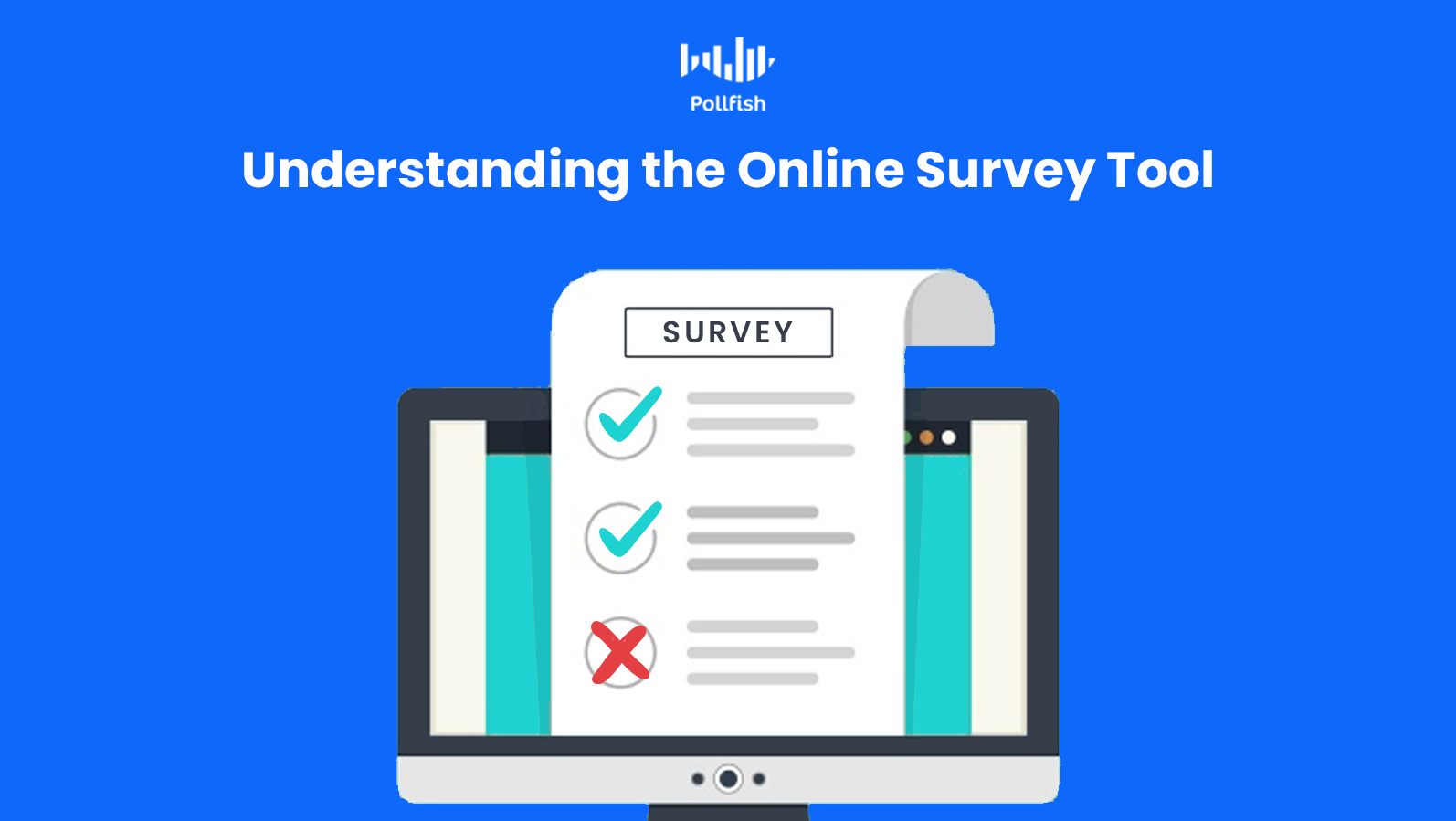
The online survey tool is the foremost tool for gaining customer intelligence for various business and research purposes.
As the digital landscape expands and competition stiffens, businesses are vying for online consumers more than ever. As a matter of fact, there are between 12 million – 24 million ecommerce websites worldwide and these figures continue to rise daily.
Tapping into the minds of customers is thus a necessity for businesses across verticals. As such, one of the most effective methods to conduct primary research on a target market is via an online survey tool.
This method systematically gathers data from respondents by inciting them to take part in various websites and mobile apps.
The internet in general is a sufficient tool for conducting secondary research. An online survey tool couples the internet as a means of distributing the survey, along with the traditional questionnaire.
This article explores what researchers and businesses alike can expect from the online survey tool.
Defining the Online Survey Tool
This tool merges the digital space with surveys, as it is a kind of software that allows researchers to form a questionnaire, set rules on respondent qualifications and deploy the full survey across partnering websites and apps.
The survey portion of the tool often incorporates two major components: the screener and the questionnaire. The screener portion allows researchers to set conditions on who to permit to move on to the questionnaire.
It collects demographic information, as market research and virtually all others aim to study particular demographics. It also has a section for screening questions, the answers of which determine whether the respondents are qualified to take part in the survey or not.
Researchers can input any question they wish to receive a particular response. Therefore, this portion allows researchers to take a granular approach to who takes the survey. The questions can delve further into demographics, or ask about psychographic or behavioral matters.
There are several things to look for in an online survey tool. There are also various business applications of this sort of tool. In this way, brands should consider it as more than merely a vehicle for collecting question-based data.
Instead, it can provide valuable feedback on critical business matters, such as for improving marketing efforts, advertising, branding and others.
Other Key Functions in a Survey Platform
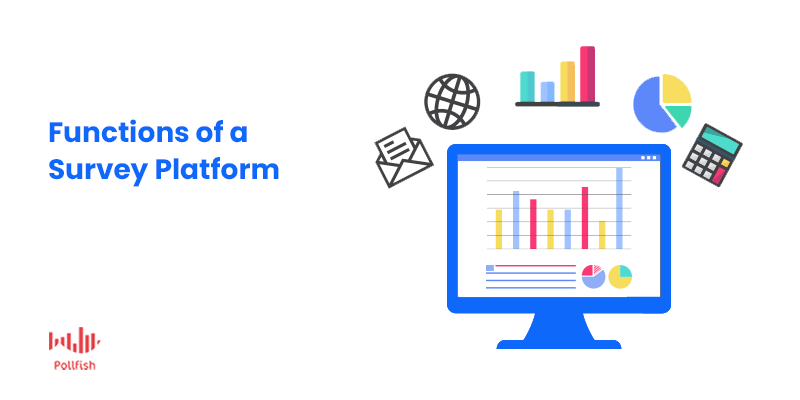
An online survey tool doesn’t simply create and distribute surveys, not if it’s a potent one, that is. A valuable survey platform offers other functions.
For example, with so many survey software available, researchers often take a dual or even multi-pronged approach for their survey research. As such, a strong survey tool will allow integrations between survey tools. This can mean acting as the third-party survey distributor of a survey created in another platform.
Another function involves creating multiple paths in a single survey, so that respondents are only channeled to questions best suited towards their answers. This involves using advanced skip logic, which routes respondents to the appropriate question based on the answer they provided.
For example, if a question asks whether a respondent is familiar with a certain brand, they would need to be moved to a follow-up question about the brand — if they responded with “yes,” but not if they responded with “no.” The latter would require another question that better suits it logically, such as a one about awareness of a different brand.
A strong online survey will also allow researchers to create multiple audiences within one survey. This entails that each audience type can have completely different demographics and quotas for each demographic. The purpose of using multiple audiences per survey is to gain insight across as wide a target population as possible in one interface.
Some survey campaigns will require researchers to do just that.
How Data Is Stored & Presented
Dovetailing off additional functions, an online survey tool stores data and a robust tool can extract the data into multiple formats. The platform itself serves as a database for all the surveys conducted, along with their collected information.
Some platforms enable researchers to extract survey data into various file types. For example, researchers can export their data as cross-tabs (cross-tabulation). This data presentation format allows users to aggregate data and analyze the relationships between variables. The variables are displayed in a matrix, i.e., in rows and columns in a matrix for researchers to quickly find data in corresponding cells.
There are other formats that online survey tools support can export. These include PDFs, Excel sheets and SPSS. The latter is the statistical analysis and machine learning tool from IBM.
While these help create a more diverse survey research campaign, it is key to note that not all online survey tools include these kinds of data exports. Some may have fewer options, while others none at all.
Aside from different formats of exported files, the data displayed per each survey can also be viewed in different ways. These include tables, pie charts and column charts. These options grant researchers the ability to choose the visualizations they’re most comfortable with, or those that are best for a particular purpose. For example, presentations may require different displays than a research document.
A practical survey platform will offer several layouts to view and store data.
The Pros
Online survey tools offer a variety of advantages for market research and research for other sectors, such as medicine, psychology, other sciences and more. Here is a list of all the benefits you can obtain from an online survey tool.
- Ease of data collection: The online survey tool you use does all the heavy lifting for you in many ways, including collecting participants from your target market. That means no more worrying about how you’re going to get survey respondents to take your survey.
- Access to a wide pool of consumers: This kind of tool (the proper variety) deploys your surveys to a massive network of internet and mobile app users. Since millions of users frequent the web every day, you can rest assured that members of your target market will be exposed to your survey.
- Saving time and workload: Face-to-face interviews, focus groups, phone calls and the outdated mail-in surveys take too much effort to execute. Besides being more labor-intensive, these methods will also consume a great deal of time that you could be spending on other market research efforts, such as secondary methods, along with other business matters. Online surveys free up much of the time you would otherwise spend on the above methods.
- Insights into personal and sensitive topics: This does not include things like names, addresses and other identifying information. Rather, an online survey tool emboldens brands to ask more personal questions, the kinds that deal with politics, social issues and matters that are private to respondents. These kinds of questions would be discomfiting for respondents to answer face-to-face and even on the phone. But with online surveys, they are granted the confidentiality to give honest answers, including in-depth answers on sensitive matters (via open-ended questions).
- Easy set-up: An online survey tool makes it easy to create a survey and design it precisely to a researcher’s needs. This makes it easy to come up with question types, as this tool offers a variety of them, such as matrix questions, rating scale questions, Likert scale questions, single selection multiple-choice, multiple selection multiple-choice, open-ended questions and more. Additionally, this tool makes it easy to add media files for picture choice questions, or a picture-based question. It should make adding things like skip logic free from friction.
- Projected time to complete the survey: A well-built online survey platform will eliminate the guesswork that comes with having your target audience complete a survey. It grants researchers an estimated completion time, so that you will know the approximate time it takes for all your preset survey quotas to be completed by the intended respondent base.
- No cost-based geographic restrictions: This means you can send your survey across the world uninhibited. If your target market has internet access, then they can take part in your survey. Most survey tools don’t charge extra for deployment to specific geographic areas. A strong survey tool also gives you the option of setting up your survey in various languages.
The Cons
As with other market research tools, survey platforms aren’t free of flaws. As such, business owners, marketers and researchers should understand the drawbacks present in this kind of research method. The following lists some of the stumbling blocks of using an online survey tool.
- Ingenuine answers: No survey is foolproof. Sometimes, the respondents may become bored or tired when taking a survey. Thus, they provide answers that are not accurate to their real opinions and phenomena that occur around them. There are flatliners, those who answer with the same choice in a multiple-choice question consecutively across many questions. Then there are the self-explanatory rule-breakers, who break survey participation rules by lying. There are several more survey respondents to look out for.
- Some populations have limited availability: Not all members of your target market have quality internet access. Some market segments, such as those who live in particular geographic areas have restricted internet access. This is evident in rural parts of the USA and poorer regions across the world. This can be especially difficult if you run a nonprofit and would like to learn more about a needy population.
- Responses are not always representative of a population: Surveys provide valuable insights, but this data is not always representative of a targeted population. Sometimes, this will require running multiple surveys, or increasing quotas. Also, since certain consumers change their minds, a survey tool will not catch this unless there are follow-up surveys sent to the exact same users who took an initial survey. You will need to pay attention to the margin of error to avoid unrepresentative opinions.
- Repeated survey requests may annoy respondents: Depending on the publisher site or app that the survey is deployed in, and the survey tool itself, there may be repeated requests to take the survey. This is bound to irritate users, which carries the risk of their ignoring the survey, or at worst, leaving the site.

When to Use an Online Survey Tool in the Market Research Process
Researchers can employ this kind of tool at virtually any point in their research process. When conducting market research, it is best to begin with sources of information already made available, aka, secondary research. This will guide your business on the happenings, trends and innovations within your sector and niche.
Moreover, you can use secondary sources to study your direct and close competitors. This includes looking at statistics websites, along with blogs, news sites, forums and others that report and cater to your industry. It is also apt to study the websites of your competitors to see how their products, service and experiences compare with yours.
After you’ve gathered a suitable amount of secondary data, you can make certain inferences on your particular marketing plans or other business goals. At this point, you’ll find some unanswered matters arising, at which point you can generate specific questions you need from your target market. This is where the survey process begins.
During this point, it would be useful to design surveys for specific campaigns and aligning the surveys with the needs of a specific campaign.
The Verdict on the Online Survey Tool
Survey research requires surveys, as its name implies. An online survey tool is the most powerful source of primary information, because it allows researchers to ask any questions and get answers relatively quickly from their most sought-after target audience.
This tool supplies all the privacy a respondent needs to confidently and truthfully answer much-needed research questions. Researchers can rejoice in having their surveys distributed across a massive network of online publishers where their surveys will iterate until all the quotas are met and the preset survey amount is completed.
Also, since customers spend much of their time online anyway, why not approach them in their natural digital environment? Thus, despite any flaws or slight difficulties the researchers may encounter, our verdict is that an online survey tool is of the essence for a research campaign.
Frequently asked questions
What is an online survey tool?
An online survey tool is a type of SaaS, defined as a platform that allows surveys to be created, distributed, and analyzed completely within its providing survey platform.
What are some of the extra functions included in a strong online survey platform?
Survey platforms differentiate themselves by offering additional functionality such as distribution on third-party sites or apps, advanced skip logic, the ability to create multiple audiences, and advanced data analysis tools.
What are cross-tabs?
Cross-tabs, or cross-tabulation, is a way of organizing data that allows the user to analyze and understand the relationship between variables.
What export formats should you look for when assessing an online survey tool?
Good online survey tools will offer the ability to export data in a variety of formats including, PDFs, Excel spreadsheets, CSV, and SPSS.
What are some benefits of using an online survey tool?
There are many benefits associated with online survey tools including ease of creation, distribution and data collection, access to a wide variety of participants, and lower cost than other methods of survey distribution.
Building Effective Prospective Studies with Online Surveys
Building Effective Prospective Studies with Online Surveys
Prospective studies are a powerful form of research to understand how the behaviors, attitudes, feelings, and/or physical attributes of a population develop over time.
Particularly, researchers and marketers are using prospective studies to understand outcomes more broadly. For example, perhaps a brand needs to study how a customer or customer segment developed a certain habit, whether it is favorable or unfavorable to the business.
While researchers typically have a primary objective in conducting prospective studies, the data that is collected over time may reveal factors that were not considered when outlining the study’s original objectives.
Given the large amount of data that is gathered over time, prospective studies are a treasure trove of information for researchers. While it takes time and patience to collect the data, the results of a prospective study may yield completely new or unexpected insights.
Defining Prospective Studies
Once the territory of public health researchers, prospective studies have entered a wider area of study due to the application of survey research.
Prospective studies can help understand the factors that influence anything from consumer loyalty to employee retention to customer churn.
In prospective studies, data is gathered from individuals over a period of time. The data is then analyzed with the objective of identifying associations between variables. Traditionally, prospective studies have been most strongly associated with the fields of public health and medicine.
Prospective studies fall into the broader category of cohort studies, which are used to determine how often a phenomenon occurs within a specified population. Retrospective studies are another type of cohort study but differ from prospective studies in that they investigate an outcome that occurred in the past.
In research studies, the term “cohort” refers to a group of people who share common characteristics, which help define them as part of the sample group. The defining characteristic can be:
- demographic in nature, i.e., age or location
- behavioral i.e. where consumers purchase a product or how they use a certain digital property )
- psychographic, i.e., values, opinions and inclinations.

A unique aspect of prospective studies is that researchers fully plan and design the study, recruit participants, and collect initial information before any of the participants develop remarkable outcomes. Researchers must watch and wait for outcomes to develop before they draw any conclusions.
Prospective studies were previously cumbersome to conduct due to the need to follow a group of people and collect data over longer periods of time, but the use of prospective surveys has made this type of longitudinal research more accessible to a wider variety of organizations.
Examples of Prospective Studies
Some of the most famous prospective studies have been conducted within the field of medicine. The outcomes of the studies mentioned below have helped solidify our understanding of how certain factors influence our overall health.
- The Framingham Heart Study is an ongoing study that started in 1948 with an original cohort of 5,209 healthy individuals located in the town of Framingham, MA. With the objective of identifying major cardiovascular disease risk factors, this study has fundamentally changed our understanding of cardiovascular health.

- The Nurse’s Health Study refers to two of the largest investigations into the risk factors that contribute to chronic disease in women. The studies began in 1976 and have followed a total of 280,000+ participants over three generations.
While prospective studies are particularly useful in following medical developments, they are also used to reveal deep and sometimes unexpected insights in business subsectors and other verticals. Here are some examples of scenarios in which businesses can apply prospective studies:
- Researchers want to understand how early exposure to social media influences the feelings and attitudes of young adults. They plan a 10-year study to follow a cohort of children who are 9-11 years old at the outset of the study.
- A large company decides to investigate the link between certain hiring practices and long-term employee retention. This is done by following new hires over a period of 5 years, or until they leave the company.
- A large online retailer plans a study to understand how buying behavior changes with age. Their prospective study will follow a large sample of 20 - 30-year-old customers for a period of 20 years.
- A SaaS company wants to understand how consumer loyalty changes over time. They decide to conduct a prospective study that follows anyone who signs up for their software subscription during 2021.
- A global beverage company wants to understand how health and lifestyle choices influence customer behavior. They decide to conduct a prospective study following a cohort of Millenials over 10 years to better understand their decision-making process.
Use of Surveys in Prospective Studies
Since prospective studies are often conducted over a long period of time, an important aspect of planning a prospective study is to determine how to collect and organize data during the study. In the past, the enormity of this challenge was one of the reasons why prospective studies were rarely undertaken outside of the public health sector.
The advent of online survey platforms has made it easier to conduct prospective studies and analyze the resulting data. After establishing the cohort, researchers can easily design and distribute surveys at predetermined intervals and allow the respondents to complete the surveys within an allotted period of time.
In comparison to older methods of data collection, such as phone or in-person interviews, online surveys provide a flexible and cost-effective way to interact with the cohort where and when it suits them best.
In addition, data collection is seamless, with data being automatically compiled with each survey iteration. Whereas prospective studies previously required a team that was well-versed in survey data collection and analysis, online surveys have made it possible for marketers to use prospective studies without needing to engage an outside company.
The Pros and Cons of Using Surveys in Prospective Studies
While surveys are a relatively easy way to collect data from a cohort, especially over a longer period of time, there are pros and cons to consider before choosing to use this method.
Prospective surveys are typically more cost-effective than conducting in-person phone interviews over a period of time. You may also experience a higher survey response rate by allowing the respondents to complete the survey when and where it is convenient for them.
If you decide to use an online survey platform to conduct prospective surveys, you will benefit from the ability to more easily complete, export, organize, and analyze data. This is an important consideration if you think about the large volume of data that will be collected over several months, years, or decades.
Since prospective studies are often conducted over a long period of time, the cost of data collection may be a barrier for certain organizations. The use of online surveys can help minimize this cost by reducing the need to hire specialized personnel to design the study and gather feedback.
On the other hand, there are some benefits to conducting interviews or performing physical exams. During the repeated interactions with the interviewer, the respondent may come to form a relationship that helps them feel more comfortable about answering the questions. This may allow for more honest or unexpected responses, which may not occur with the use of a survey.
Similarly, the design of a survey can greatly affect the results. With a limited set of responses, there is less flexibility to uncover unexpected or new responses. This can be avoided by including open-ended questions or text entry fields to submit additional information.
Gaining Deeper Understanding with Prospective Studies
Thanks to online survey platforms, it is possible for more organizations to benefit from the ability to gather data from their respondents over a period of time. If you are looking for a way to gain a deeper understanding of how certain factors influence the thoughts and behaviors of your customers over time, consider conducting a prospective study.
There is no denying that prospective studies take a great deal of effort to plan and manage, but the results of this type of study can lead to completely new insights and understanding of your target market
This allows you to innovate on your offerings, personalize your customer experience (CX) and foster stronger marketing efforts, all of which will help scale your business.
Frequently asked questions
What is a prospective study?
A prospective study is a longitudinal cohort study that studies a group of similar respondents with only a few differing factors to determine how these factors affect an outcome or outcomes.
What is a cohort study?
A cohort study is used to gather information about a group of people who share common, defining characteristics (i.e. a cohort) over a period of time.
What is longitudinal research?
Longitudinal research is a type of research that is performed over a period of time to understand the relationship between the same variables in an observed population. The period of time ranges from several weeks to years to decades.
What are the benefits of using surveys in a prospective study?
Surveys are a cost-effective way to collect information in a prospective study, in which data collection costs tend to be higher due to the longer period of study They also encourage a higher survey response rate and allow researchers to easily compile and analyze the huge amount of data that is collected during the study.
What are some disadvantages of using surveys to collect data in a prospective study?
Surveys do not allow the participants to form a connection or relationship with the researcher, which can be beneficial because it may result in deeper, more honest insights. They also do not allow for physical examination, for example by a doctor or nurse, which can provide additional data to support the study.
The Product Satisfaction Survey Question Guide
The Product Satisfaction Survey Question Guide
Product satisfaction survey questions power their namesake survey, which allows businesses to quickly gain valuable information about their products directly from their paying customers.
Well-designed product satisfaction survey questions will not only measure how satisfied your customers are with your product(s), but also provide valuable information about how to improve your product or the product experience.
How you create your product satisfaction survey questions can make the difference between lackluster insights and those that can drive real change for the future of your product.
This article will help you understand how to create strong survey questions that will elicit useful responses that drive improvements, innovations and profitability.
Planning Your Product Satisfaction Survey Questions
The product satisfaction survey comes in a variety of formats and lengths. Your motivation for conducting a product satisfaction survey will influence the survey format that you decide to use.
In many cases, companies will conduct a variety of surveys over a period of time, with each survey type designed to fulfill a specific purpose.
Here are two principal considerations for these questions:
- If your company sells many different types of products, it may be useful to deploy a short product satisfaction survey on each product that customers bought. In order to ensure an optimal survey response rate, your survey questions should remain at just a few critical questions.
- On the other hand, if your company develops high-end products or ones that require a longer period of use before a customer could rate it, you may benefit from surveys that are distributed less frequently but ask more in-depth questions.
In the following section, we provide examples of different types of product satisfaction survey questions. These questions will help you get started, whether you choose to create a survey with 2 questions or 10!
Questions about Overall Product Satisfaction
At the outset of your survey, you should seek to understand your customers’ overall product satisfaction. To get a greater number of responses, consider having just 1 or 2 questions in this part of the survey, followed by an optional second part that dives deeper into the product.
Overall product satisfaction can be understood by asking one or more of the following questions:
- How satisfied are you with this product?
- If you wish to use the Customer Satisfaction Score survey (CSAT) format, the response should be provided on a 1 - 5 scale, with 5 indicating “highly satisfied.”
- Alternately, you could use a visual rating system using emoticons or create your own multiple-choice responses (e.g. “I love it!” / “It could be better.” / “I regret buying this product.”)
- How likely are you to recommend this product to a friend or colleague?
- This is the golden question asked in a Net Promoter Score (NPS) survey, which is popular because it can help companies quickly gauge overall product satisfaction. The response is provided on a scale of 1 - 10, with 10 being “most likely to recommend.”
- You could also use binary (yes/no) or multiple-choice responses for this question.
- How likely are you to purchase this product again?
- Responses can be scaled i.e.,. 1 - 10, with 1 being least likely, or multiple choice (“I would definitely buy this product again!” / “I might buy this product again.” / “I would not buy this product again.”.
- How easy is it to use this product?
- If your product has many features, consider using the Likert scale to get responses about each of its features.
Questions about Product Features
If your product has multiple features or uses, you may need to get a better understanding of how each feature contributes to product satisfaction or dissatisfaction. This can help you decide how to improve, create, or retire certain product features.
In this section, you may wish to include a combination of close-ended and open-ended questions to give your customers the opportunity to provide additional feedback.
- Where do you use this product?
- Multiple-choice response (e.g. “At home” / “At work” / “At home and at work”)
- A Matrix or Likert scale if you want to understand how frequently the product is used in certain situations.
- A text entry field
- Why did you purchase this product?
- Multiple-choice response
- A text entry field
- Which of the following features do you use and how often?
- To quickly gain information about various features, use a Matrix to gather information about the product features. The Matrix can have a list of product features in the first column, with responses along the top row, such “I use it every day.” / “I use it occasionally.” / “I rarely use it.”
- How would you rate each of the following features?
- A matrix with scaled responses is a good way to quickly assess satisfaction with each product feature.
- What can we do to improve this product for you?
- The response can be a text entry field to give customers the opportunity to provide spontaneous feedback, as you never know where the inspiration for your next product feature will come from.
- You could also use multiple-choice responses to prompt users to think about certain ways to improve the product, i.e., “Improve the on/off switch.” / “Include timer functionality.”
Questions about Price and Quality Balance

How your customers perceive the balance between the price and quality of your product can affect their overall satisfaction levels. These questions can help ensure that your pricing strategy is appropriate for your customer base.
- How would you rate the price of this product?
- The response may be scaled or multiple choice (i.e.e.g. “Too expensive” / “somewhat expensive” / “as expected” / “less expensive” / “much less expensive”).
- If this product was priced at [insert a lower value here], how would you describe your feelings?
- Multiple choice answers with responses such as: “I would start to doubt the quality of the product and might not purchase it. / “I would think it was a good deal and would consider purchasing.“ / “I think this is a better price for the product.”)
- How likely would you be to try this product if it were priced at [enter a value you wish to test here]?
- Scaled answer, with 1 being extremely unlikely and 5 being extremely likely.
Questions to Help with Product Innovation
One of the most exciting aspects of evaluating product satisfaction is the opportunity to learn how your customers would like to see your product evolve in the future. This is your opportunity to explore potential features and, potentially, uncover some unexpected ideas.
- Please rate how likely you are to use the following features:
- For this question, a matrix will allow you to understand how likely your customers would be to use any number of potential features. List out the features and allow users to select from options such as: “extremely likely” / “likely” / “unlikely” / extremely unlikely.”
- What is the one thing that you wish this product could do?
- Multiple choice (list out potential features that could be added)
- Text entry field to allow for free-form responses.
- What do you like least about this product?
- Text entry field
- Multiple choice (list out some of the potential flaws in your product).
- What do you like most about this product?
- Text entry field
- Multiple choice (list out some of the most important features of your product).
Questions about Product Retention

Finally, you may wish to explore how product retention affects satisfaction. Long-term company profitability has been linked to how long customers keep a product, so this is an important metric to explore. This information can also be used to segment your customers and understand how product retention affects satisfaction levels.
- Did you keep this product?
- Binary response.
- Those who answered “no” could be directed to the following questions.
- If you did not keep this product, what did you do with it?
- Multiple-choice answer (e.g. “Returned it for a refund.” / “Exchanged it for another similar product.” / “Gave it away.” / “Threw it in the trash.”
- Why didn’t you keep the product?
- Multiple-choice answer (e.g. “I wasn’t happy with the quality.” “It didn’t work properly.” “I found a better price.”)
- Provide an optional text entry field for additional information.
- How long did you use the product before you returned or discarded it?
- Multiple choice response (e.g. “1 day” / “3 days” / “1 week” / “Longer than a week”).
Tips for Creating Strong Product Satisfaction Survey Questions
Regardless of the type of survey you choose to conduct, it’s important that you give careful thought to each question. Here are some tips to keep in mind:
- Ask questions about overall product satisfaction first, before diving into more specific questions.
- This ensures that you have at least one strong metric to track over time.
- Keep the survey short and focused to ensure an optimal response rate. Aim for 3 - 6 well-written questions (less if you are using the NPS or CSAT format).
- Give participants the opportunity to provide additional feedback by including open-ended questions with text entry boxes.
- This type of question should be optional, so it doesn’t prevent other users from completing the survey.
- Consider using a combination of quantitative and qualitative survey questions to gain a 360-degree view of your product from the customer’s perspective.
- Ensure that each question has a single focus. Cramming two questions into one will confuse your respondent.
- Use clear language and avoid using industry jargon. This helps respondents understand each question and pick the appropriate answer accurately.
To learn more about creating powerful survey questions, visit our comprehensive guide about creating survey questions and responses.
Better Planning with Product Satisfaction Surveys
Product satisfaction surveys are essential tools for granting companies the ability to understand much more than just overall satisfaction levels. These tools can be used to help chart out the course of your product by learning how to improve it over time.
Whether you choose to deploy a short survey or a more comprehensive one, you will gain invaluable data that describes exactly how your customers feel about your product. By taking the time to plan out more detailed questions, you can also make smart decisions about adding new product features and improving or retiring existing ones.
Unlike many other survey types, your audience is preselected, which means you don't need to go hunting for people to take your survey. Once you take the time to create strong product satisfaction survey questions, simply distribute the survey to your customers and get ready to dig into the data.
Frequently asked questions
What is a product satisfaction survey?
A product satisfaction survey is any type of survey that is conducted in order to better understand how satisfied existing customers are with a company’s products.
What types of companies can benefit from product satisfaction surveys?
Any type of company, from brick-and-mortar shops to online stores, that sells products can benefit from conducting product satisfaction surveys.
Why is it important to ask questions about product features in a product satisfaction survey?
Companies can gain a better understanding of which product features are beneficial and which are problematic by carefully examining the various features in a product satisfaction survey.
Why is the Net Promoter Score (NPS) a useful product satisfaction survey question?
Based on a scale of 1 - 10, the Net Promoter Score (NPS) seeks to measure how likely a customer is to recommend a company’s product to a friend or colleague. This simple indicator gives the company an overall idea of how satisfied customers are with their product.
What is the right number of questions to include in a product satisfaction survey?
Product satisfaction surveys can contain any number of questions, but short surveys of 3 - 6 questions are more likely to yield an optimal response rate.

